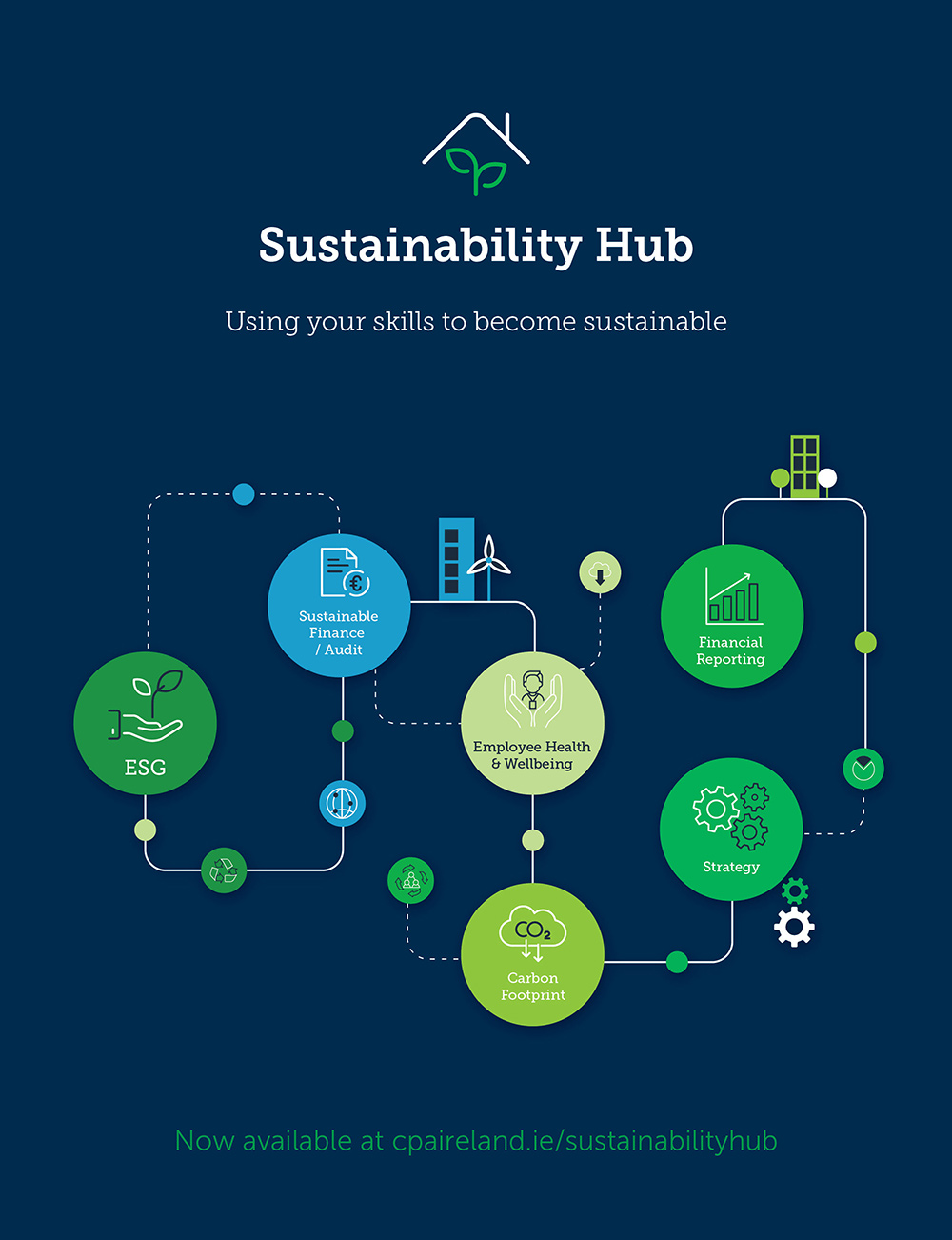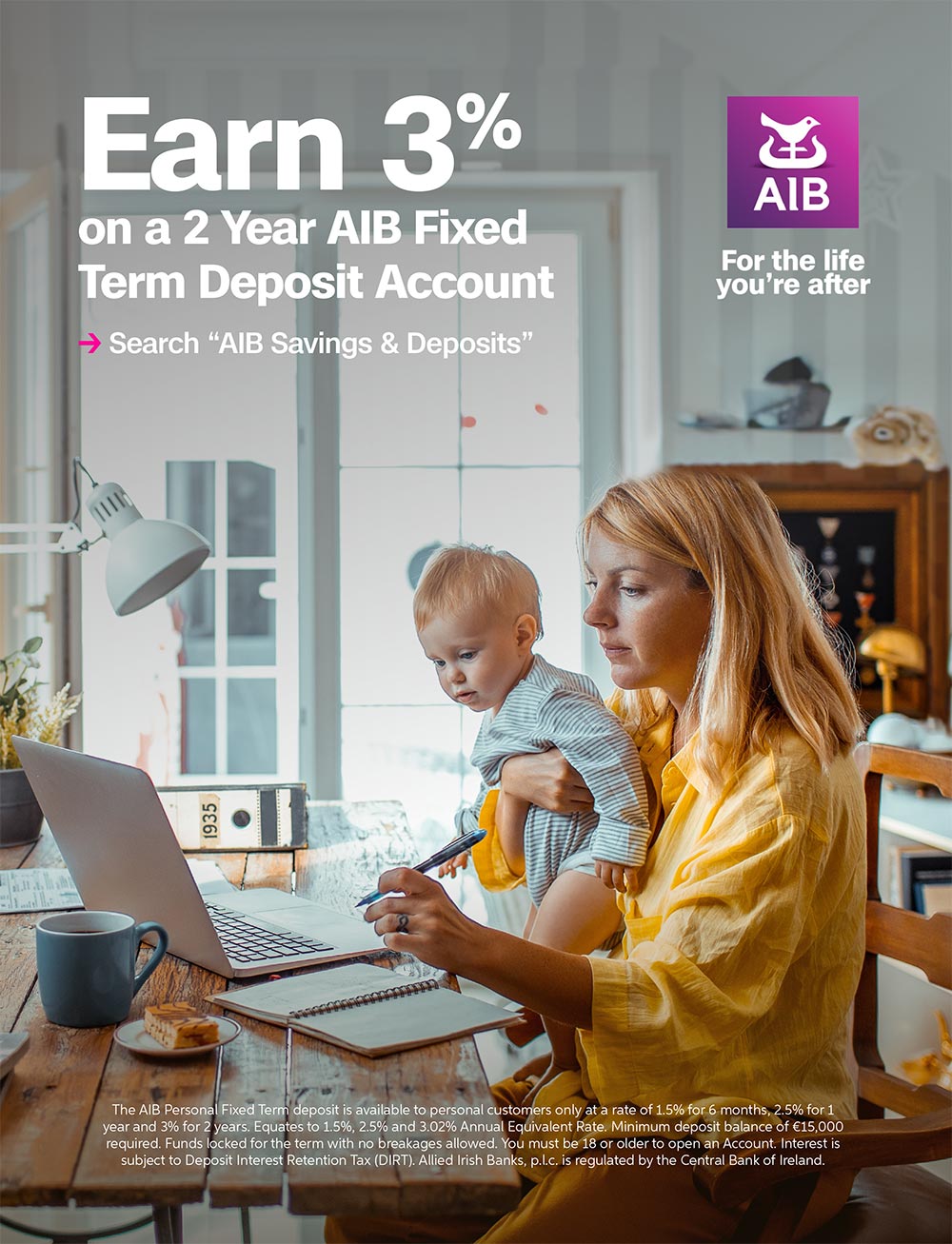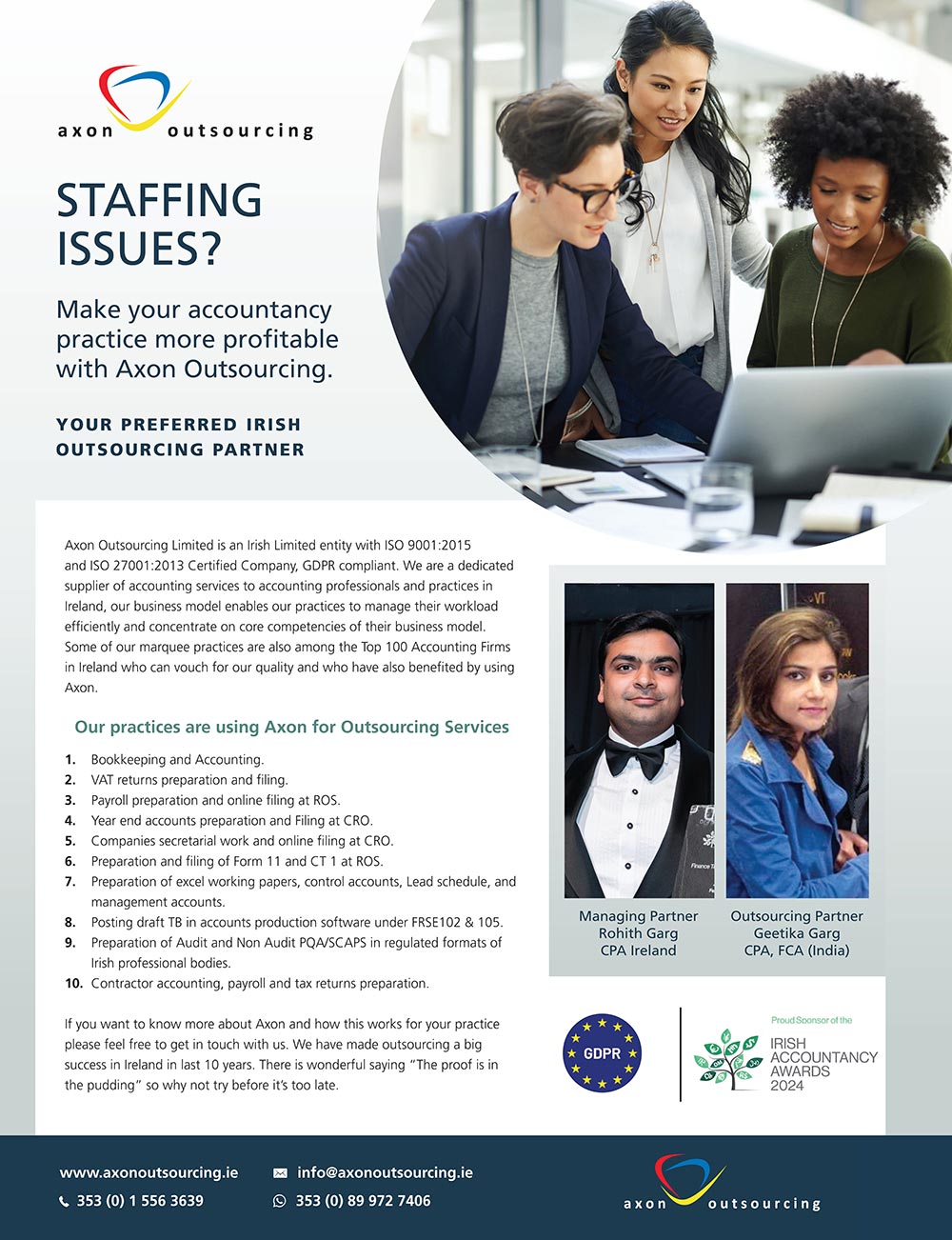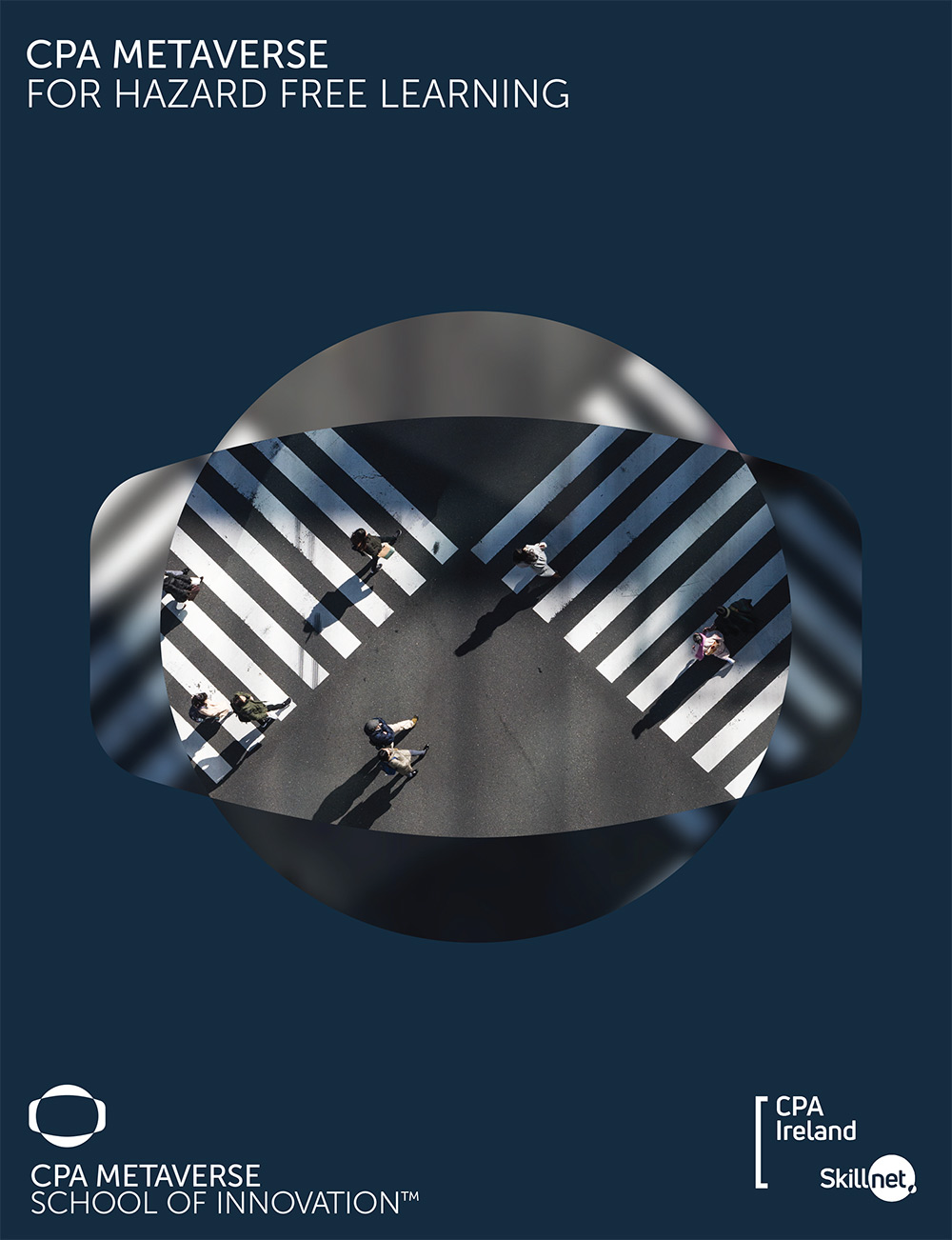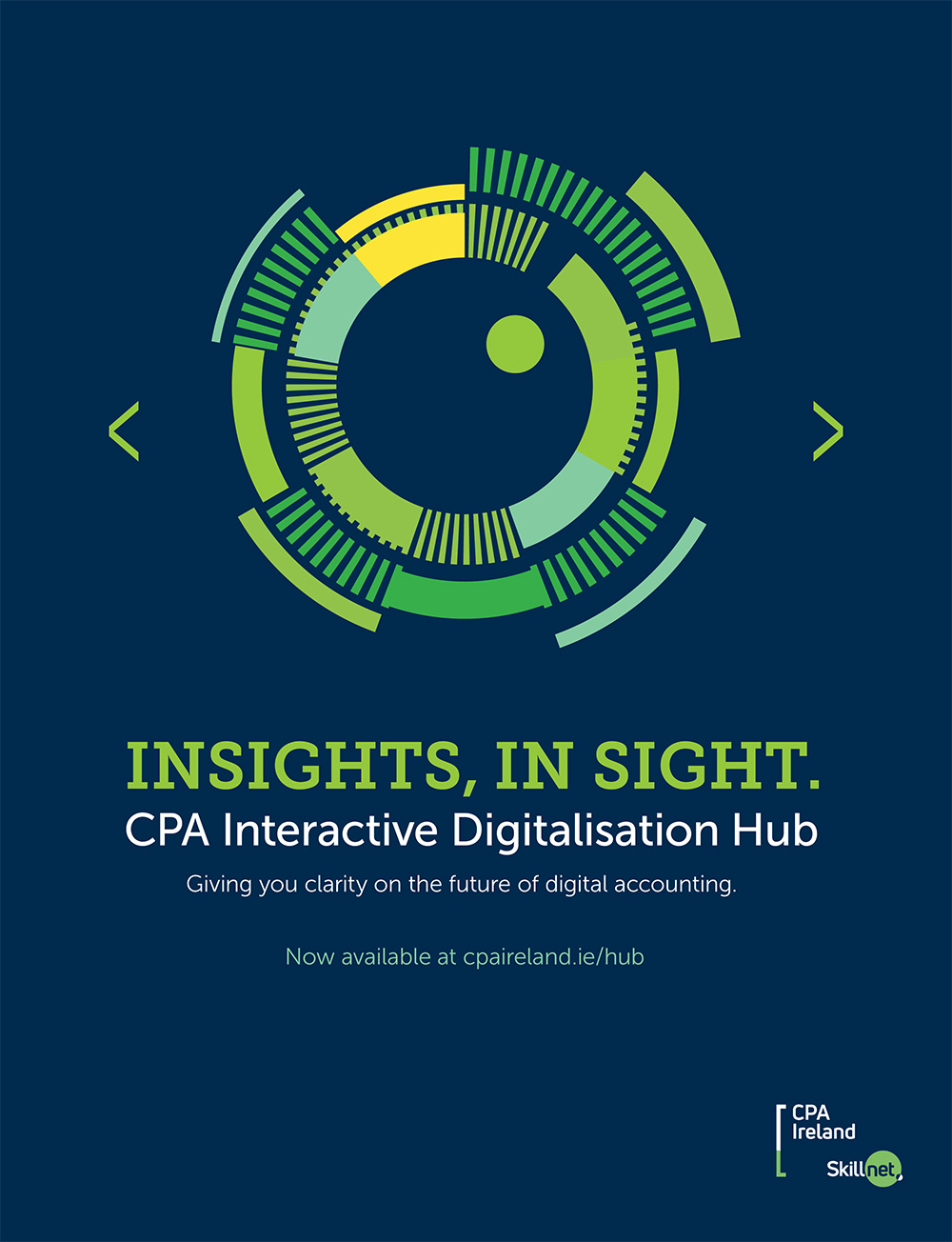Education & Sustainability


March 2024
17 Harcourt Street,
Dublin 2, D02 W963
T: 01 425 1000
F: 01 425 1001
Unit 3,
The Old Gasworks,
Kilmorey Street,
Newry, BT34 2DH
T: +44 (0) 28 3025 2771
W: www.cpaireland.ie
E: cpa@cpaireland.ie
Patricia O’Neill
Chief Executive
Eamonn Siggins
Editorial Adviser
Róisín McEntee
Technical Adviser
Phyllis Willoughby
Jenn Brennan
T: 087 203 4202
E: accountancyplus@gmail.com
Caitriona Minogue
T: 086 843 0622
E: accountancyplus@gmail.com
Published by
Nine Rivers Media Ltd.
E: gary@ninerivers.ie
President’s Message
Welcome to the March 2024 edition of Accountancy Plus.

We then undertook an extensive campaign to engage with our members, through which we shared our vision for a single, Irish-based, accountancy body that would be better placed to address the opportunities and challenges of the future and ensure a sustainable accountancy profession in Ireland.
I am pleased to report that following a membership vote at the Extraordinary General Meeting on Wednesday 21st February, this proposal was approved.
The proposal was passed by an overwhelming majority of our membership, with 97% of those voting supporting the proposal. I see this as an endorsement of the benefits this amalgamation will bring and the desire amongst members for a strengthened future for our profession.
This is a decisive step forward for Irish accountancy. As a single Institute, and the largest professional body on the island of Ireland, we will be in the best possible position to advance the health and sustainability of the accountancy profession. This new Institute will benefit from expanded resources, greater influence, and a larger membership base. This will help attract new entries into our sector, and further our ultimate goals of advancing educational standards, supporting the public interest, and providing value to our members.
It was fantastic to see our membership display such interest and enthusiasm in the future prospects of our profession during the course of this campaign. The attendance of so many members at our town hall meetings, both those held in person around the country and virtually, was very impressive. It inspired a thorough and thoughtful discussion of what we can do to increase student uptake, inform public policy, and provide the best quality of services for our members.
I, along with the other members of the CPA’s Council, am confident this amalgamation will deliver these benefits. As such, I would like to thank you for your consistent and earnest engagement with this proposal, and for ultimately giving it your seal of approval.
We look forward to carrying on our traditions of educational excellence, the highest professional standards, and strong member supports into our new home.
The members of Chartered Accountants Ireland also endorsed this amalgamation proposal at a Special General Meeting held on Wednesday 21st February.
We can now begin the next steps of this process. Over the next few months, we will continue to work closely with our counterparts at Chartered Accountants Ireland to secure regulatory and legal approval for this amalgamation. We will also discuss how the staff and Councils of both organisations will work together following amalgamation, ensuring that CPA Ireland’s proud legacy of service to members and the culture and heritage of our Institute will be maintained and enhanced in the newly amalgamated Institute.
We will make sure to keep our members informed throughout this process.
Once all requirements have been approved by IAASA and other relevant regulators, an application will be made to the High Court asking it to sanction this amalgamation. After this, we will complete the process and begin our renewed efforts to support our profession.
There are exciting times ahead for our profession, our students, and our members.
Now that the amalgamation has been approved, all members of the newly amalgamated Institute will soon be able to reap the benefits of a larger, stronger, more influential Institute. In the meantime, I look forward to engaging with you, addressing your concerns or questions you may have, and continuing to serve the membership of this body for the rest of my term.

President CPA Ireland
CPA Profile
CPA Profile
Conor Molloy
CPA Profile
Conor Molloy
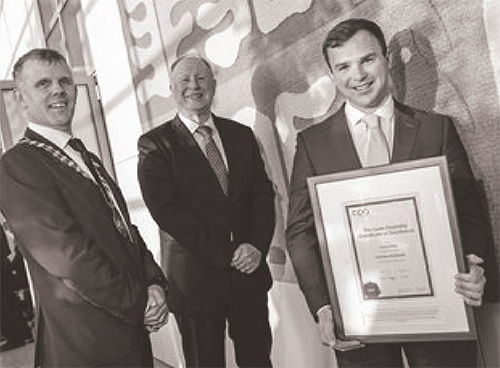
Title: Accountant
Company: Clonmel Waste Disposal
Qualifications: CPA
There is a wide range of areas where an accountant contributes to the firm from cost analysis to management accounts, and of course they could provide me with first class mentoring. I am delighted to have completed the CPA qualification in 2023.

I can’t forget Michael O’Leary, however. I’ve read all his books and still get a kick out of them. He must be the coolest accountant I know.
It can be challenging at times but so worthwhile. Work-life balance is a priority and something I definitely needed while studying, so make sure you spend time doing the things you love.
I am also trying to fit in some travel after the pandemic scuppered my post-university plans. I am really enjoying exploring different cultures and landscapes, and certainly looking forward to the exam free year ahead!
CPA Profile
Ann-Marie Reddy
CPA Profile
Ann-Marie Reddy

Title: Principal
Company: Grant Reddy Fitzgerald / Blackthorn Capital
Qualifications: FCPA, CTA

What we do just would not work without her.
SUSTAINABILITY
How can SMEs start their sustainable transition? by Johan Barros
To help SMEs and their trusted advisors (such as accountants) with that, Accountancy Europe, Ecopreneur.eu – the European sustainable business association – and the European Association of Cooperative Banks (EACB) jointly published, at the end of 2023, new guidance documents.
The first one of these papers outlines five reasons why SMEs should take the sustainable transition seriously. The second one provides five first steps that a SME can take to kickstart their sustainability journey.
The papers were based on interviews with small and medium sized practitioners (SMPs) that are already providing or planning to provide sustainability services for SMEs. They also benefitted from considerable technical input and insights from experts from all three organisations.
The main message of these guidance documents? Just get started!
Consider, for example, the competitive advantage. SMEs with sustainable business models can expand their range of clients and business partners. This can happen, for example, by being better placed to secure contracts with larger companies who are legally obliged to consider the overall sustainability of their value chains.

For example, the costs of investment in a new plant or equipment may be offset by increased energy efficiency, especially at times of skyrocketing energy prices and when grants are available to finance energy-efficient assets.
Sustainability can even affect the business’ succession planning. A sustainable business that is adapted to the needs and realities of the environment is more resilient in the longer term and makes the next younger generation more interested to continue running the family business.
The benefits of positive branding should not be underestimated. Basing a business model around sustainability is more appealing for end-consumers who seek to cut their personal carbon footprint and can improve brand loyalty. This can, in turn, also strengthen the SMEs employee retention and commitment for the business.
Access to finance is another key opportunity. Firstly, sustainable SMEs can increasingly access diverse financing options, including loans, impact investments, and grants earmarked specifically for sustainable initiatives. Additionally, governments, the EU and international organisations actively support sustainable SMEs through funding programs and incentives, further expanding their potential access to capital.
The second positive and more indirect access to finance benefit is that sustainability planning leads to stronger management structure, accounting systems and internal controls. Reporting on these sustainability actions also enhances the SMEs corporate responsibility brand. All of these are factors that make the business more attractive to lenders.
Finally, sustainability goals make businesses focus on long-term strategic planning, instead of short-term results. It renders the business more risk resilient and adaptive, which should also improve their ultimate sale value.
The above are just a few positive examples for SMEs and their advisors to consider. Each of them should be carefully considered from the perspective of the specificities of each SME and their business model.
Some first simple steps, as outlined in Accountancy Europe’s papers, can be done by practically every SME. The best approach is to identify and start with ‘low hanging fruits’, and very simple steps. This is already much better than doing nothing at all.
Reaching out to experts, information points and national associations is one of the very first steps. Could the national SME association or chamber of commerce have resources and support for SMEs? Or could the national accountancy institute have information about local practitioners who support SMEs with sustainability? There is also the chance that the SMEs existing accountant can help or knows of someone within their network who can.
Another crucial step is to reflect on the business’ future vision, a process that can be guided by far-reaching questions, e.g.:
- Where does the owner see the SME in 5 or 10 years?
- What about in 20 years?
- Does the business model contribute to climate objectives?
- If not, what needs to change?
- How will the owner get the data to plan and monitor the change?
Many SMEs may be already ‘sitting’ on a lot of sustainability related data without even realising it. Data points such as gas and electricity consumption, material used in the production process, recycling practices, remuneration policies or gender balance should already exist.
Other data points – such as how the SME’s electricity provider’s energy is produced or employee satisfaction – should be relatively easy to obtain.
What about the SMEs value chain? Is the company overly reliant on key customers or suppliers with higher sustainability risks or exposures?
See the paper on five first steps for more insights on how a SME could get started – or how SMEs’ accountants can advise their clients.
Additionally, accountants often have a strong network of other experts and professionals to whom they can refer the SME when necessary.
They can, for example, help SMEs communicate with their value chain partners. Most accountants are not environmental engineers or energy experts – but they are experts in legal requirements and business planning.

Accountancy Europe
Value Chain and CSRD Reporting by Sheila Stanley

The CSRD requires value chain reporting, which covers the activities, resources, and relationships the reporting company uses and relies on to create its products or services from conception to delivery, including consumption and end-of- life. Activities, resources, and relationships along the value chain include the following:
- those in the company’s own operations, such as human resources;
- those along its supply, marketing and distribution channels, such as materials and service sourcing and product and service sale and delivery; and
- the financing, geographical, geopolitical and regulatory environments in which the company operates.
Value chain actors are found both upstream and downstream from the company. Actors upstream from the company include suppliers and provide products or services that are used in the development of the company’s products or services. Actors downstream from the company include distributors and customers who receive products or services from the company. In many cases, SMEs will find themselves either as suppliers or distributors in the value chain of a reporting company.
In December 2023, the European Financial Reporting Advisory Group (EFRAG) released a set of guidance documents to help companies comply with the requirements of the ESRS. Of these, the IG 2: Value Chain Implementation Guidance provides useful insights for SMEs in the value chain of large companies to consider.
As actors in the value chain of larger companies reporting under the CSRD, what can SMEs expect to face and how can they prepare themselves?
- Companies that were previously reporting under the Non-Financial Reporting Directive (NFRD) are to report on their FY2024 sustainability performance with limited assurance in the year 2025. Unlike the CSRD, the NFRD did not mandate companies to report on their value chain.
- Other large companies are to report on their FY2025 sustainability performance in the year 2026.
- Listed SMEs are to report on FY2026 performance in the year 2027.
Large companies – both listed and unlisted – refer to an EU undertaking or EU subsidiary of a non-EU entity that satisfies at least two of the following criteria:
- More than €50 million in net turnover (i.e., revenue)
- More than €25 million in balance sheet total (i.e., total assets)
- More than an average of 250 employees during the year
As of 1 January 2024, the ESRS came into effect through the adoption of the Commission Delegated Regulation (EU) 2023/2772 (ESRS Delegated Regulation). The ESRS Delegated Regulation provides details of the sustainability-related disclosure requirements that companies are to report on. The determination of which sustainability matters a company is to report on is based on the principle of double materiality.
Double materiality essentially refers to two dimensions of materiality – impact materiality which covers the company’s impacts on people and the environment, and financial materiality which covers risks and opportunities related to sustainability matters that affects the company’s development, financial position, financial performance, cash flows, access to finance or cost of capital over the short-, medium- or long-term time horizons The sustainability matters that fall within the scope of the ESRS are wide ranging as outlined in fig 1.
As of the end of 2023 and moving into 2024, many companies that are in-scope for the CSRD for FY2024 have begun their double materiality assessments to ascertain which sustainability matters they will be required to report on. As part of this process, and because the CSRD requires companies to report on the value chain, these companies are reaching out to SMEs such as their suppliers and distributors to obtain their feedback as stakeholders.
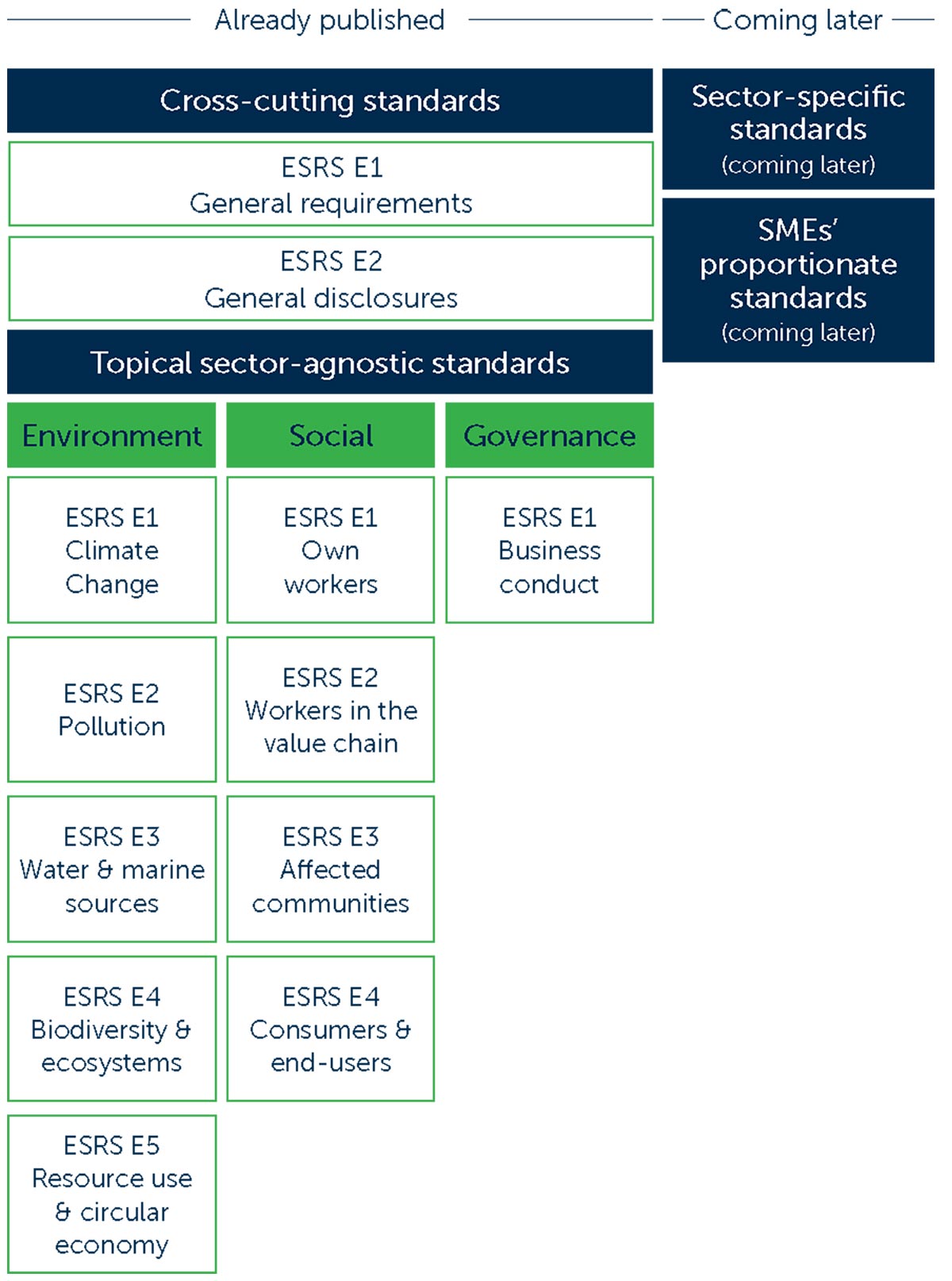
The EFRAG IG 2 Value Chain Implementation Guidance provides more clarity in terms of guidance and explanations on value chain disclosures. While the guidance was developed for use by companies that are in-scope under the CSRD and not for SMEs, it does provide some useful points for SMEs to take on board.
SMEs in the supply chain of companies preparing ESRS reports are considered part of the upstream value chain of the reporting companies, while SMEs that are distributors are considered part of the downstream value chain. The Value Chain (VC) coverage map in the IG 2 provides a snapshot of the specific disclosures within each general and topical standard that requires value chain information (See Figure 2). These cover disclosures under all 10 ESRS topical standards.
IG 2 makes it clear that a company will have to identify risks and opportunities that arise as a result of impacts and dependencies it has on its value chain to provide a fuller picture of its impacts on people and the environment which are connected to its activities, products and services. Effectively, what this means is that a company is to report on the sustainability-related impacts it may have on people and the environment as a result of its business relationships with SMEs such as suppliers and distributors that are involved in its business operations and activities. As an example, SMEs’ greenhouse gas (GHG) emissions that are the result of its business relationships with the reporting company is considered part of the Scope 3 value chain GHG emissions that the large company has to report on.
This means that companies will have no choice but to approach SMEs as part of the double materiality assessment process to obtain their feedback on potential impacts it has on the SME and conversely, to consider the risks and opportunities associated with its SME suppliers.
According to IG 2, companies will have to provide information on how their policies, actions, and targets in relation to each topical standard cover the value chain. By extension, these policies, actions, and targets that companies develop which encompass the value chain will affect how SMEs conduct their own business. SMEs will have to ensure that their own business conduct and activities are aligned with supplier/distributor Environmental, Social and Governance (ESG) and the procurement policies developed by the reporting company.
- Start having the conversation with the reporting company it is a supplier of to find out what the latter’s sustainability considerations are with regards to the products/services provided.
- Find out what information the reporting company will require under the ESRS as a result of its double materiality assessment.
- Review its own processes and systems to gauge its capacity to provide data and information to support the company’s reporting requirements.
- Start thinking about how to incorporate ESG into its business model to ensure its long-term business viability and profitability. An ESG compliant supplier/distributor will become a supplier/distributor of choice for large companies as sustainability reporting requirements further strengthen in the coming years.
- Create awareness and support the dissemination of sustainability knowledge amongst its employees. This will ensure that its employees will be able to effectively engage with the reporting company as well as implement in-house sustainability strategies and development plans that are developed to build out the SME’s sustainability value proposition.
- Adopt the right mindset. Rather than viewing this as a burdensome reporting requirement, SMEs should view this as a strategic investment and opportunity.
- Finally, make the most of government supports available for SMEs to begin their sustainability journey. These include the Green Transition Fund which provides support to SMEs to become more sustainable and prepare themselves for a low-carbon, resource-efficient future through initial planning, capability building, investment, research and innovation.
- Digital and climate transformation projects under the Green Transition Fund are being funded through the EU’s Recovery and Resilience Facility under Ireland’s National Recovery and Resilience Plan (NRPP) 2021-2026.
- Another valuable support available is the Climate Toolkit 4 Business, a toolkit that allows businesses to gauge their environmental impact based on information they have at hand such as energy, water or waste bills and create an improvement plan.

- EFRAG proposes implementation guidance for ESRS (iasplus.com)
- EFRAG IG 2 Value Chain Implementation Guidance. Available at: Download (efrag.org)
- Expected Contributions Of The European Corporate Sustainability Reporting Directive (Csrd) To The Sustainable Development Of The European Union (researchgate.net)
- Delegated regulation – EU – 2023/2772 – EN – EUR-Lex (europa.eu)
- European Sustainability Reporting Standards (ESRS) adopted by EC | EY – Global (Issue 3, August 2023)
- Climate Toolkit 4 Business | Zero Carbon Journey
- Improve sustainability | Business Support | Enterprise Ireland (enterprise-ireland.com)

Law & Regulation News
- Additional listing of over 140 individuals and entities to the sanctions list.
- A ban on direct or indirect import, purchase or transfer of diamonds from Russia.
- A direct ban applies to non-industrial natural and synthetic diamonds.
- Introduction of a no Russia clause which prohibits re-exportation to Russia of particularly sensitive goods and technology, including Russian military systems.
- Further circumvention measures relating to dual use goods and technologies, including extending the transit ban to all battlefield goods.
- Exceptions were introduced for personal use items.
- A ban on Russian nationals from holding any posts on governing bodies.
- Tighter compliance rules have been introduced to clamp down on circumvention to support the implementation of the oil price cap.
The Department of Finance ask that all entities familiarise themselves with the measures introduced and how they can comply with the sanctions.
The relevant Statutory Instruments are, or will be shortly, available on the Irish Statute Book. Further information on restrictive measures can be viewed also at:
- The EU Council website, from which the measures agreed at an EU level in response to the crisis in Ukraine can be found
- The European Commission website, from which Frequency Asked Question documents are available
- The Central Bank of Ireland
- D/Foreign Affairs – who also have domestic guidance on the implementation of sanctions at the bottom of that page.
Please monitor the websites referenced above closely in the event that further information is available or further restrictive measures are adopted. It is very important that all supervisors in particular keep up to date on developments and ensure that the obligations arising from the sanctions are communicated appropriately to all obliged entities.
All legal and natural persons are bound by the obligations in the sanctions and supervisors need to ensure compliance with same.
Should you have any queries, contact sanctions@finance.gov.ie
The Bill revises and updates the 2009 Charities Act, and is a key step that needs to be implemented in order to allow for the appropriate regulation, particularly financial regulation, of the sector.
The measures proposed will introduce greater transparency to the way in which charities report, enhancing public confidence in the sector, and will enhance and consolidate the existing legal framework for the Charities Regulator to carry out its statutory functions.
The Bill includes provisions that will ensure that registered charities that are companies will be subject to the same regulatory requirements and rules as all other registered charities. It also increases the financial thresholds which currently apply for the regulation of charities to ensure more appropriate reporting requirements that are reflective of a charity’s size.
While some remain in the planning stage like the proposed automatic enrolment scheme scheduled to be implemented before the end of 2024 and proposals for legislation that would prohibit mandatory retirement ages that are lower than the State pension age of 66.
A new flexible pension model has been available to Employees since the 1st January 2024. Under this revised State pension model, Employees have the option to continue working until the age between 67 and 70. Employees can continue to drawdown the State pension at the age of 66 in the normal way but those that choose to defer their drawdown date will receive an “age referenced rate of State pension” or an actuarially increased rate of payment.
The Essential Role of HR in Business Sustainability Initiatives by Amanda Finnegan

- 1 January 2024: For public interest entities within the scope of EU non-financial reporting regulations (with more than 500 employees), the implementation date is set for.
- 1 January 2025: Other larger companies and public interest entities (with more than 250 employees) are scheduled to adopt these rules starting from.
- 1 January 2026: Listed small and medium-sized enterprises (SMEs) are expected to comply by, although they have the option to defer their adoption until 2028.
Although small and medium-sized enterprises (SMEs) that are not publicly listed are not directly targeted by the directive, they might be required to furnish information to larger companies eventually, as part of the overall value chain.
If there is no ESG strategy in place, HR should facilitate the development of one. This strategy should seek to marry the organisational values with realistic sustainability goals and embed these values into company policies, procedures, and practices. Achievable workplace policies that promote sustainability could include reducing waste, encouraging recycling, supporting sustainable commuting options, and minimising energy use.
Adare HRM Advice: Review current sustainability policies to assess your organisation’s status. Set specific goals to minimize environmental impact, whether quarterly or annually. Identify and act on immediate opportunities to change organisational behaviours, such as eliminating single-use plastics and encouraging digital document viewing over printing. This proactive approach will align company strategy with sustainability goals and demonstrate a commitment to environmental responsibility.
2. Recruitment and Retention
Sustainable policies are becoming increasingly important from a recruitment and retention perspective. This is particularly the case among younger generations who value environmental and social responsibility.
When an organisation demonstrates its genuine commitment to sustainability, it not only enhances its brand image but also helps attract and retain employees who are motivated by working for an organisation that aligns with their own values on environmental stewardship and social responsibility. This alignment often results in a more engaged, productive, and loyal workforce, which is crucial for long-term business success.
Adare HRM Advice: Showcase your organisation’s commitment to sustainability by highlighting three specific examples where this commitment has been demonstrated. Enhance your online presence with visuals on your website and LinkedIn company page that reflect these sustainable practices. Detail the internal committees focused on sustainability and share the time allocated by executives for each team member to contribute to sustainability initiatives annually. This approach not only bolsters your brand image but also attracts and retains employees who value environmental and social responsibility, leading to a more engaged and loyal workforce and valuable Employer Value Proposition.
3. Integrate Sustainability into Performance Management
Where feasible, the reward system could include sustainability-related objectives in employee performance reviews and KPIs. Employees and teams who make significant contributions to sustainability efforts should be recognised and rewarded for their efforts.
Adare HRM Advice: Recognise and reward employees who actively demonstrate their commitment to sustainability. Consider featuring their contributions on your company’s website or LinkedIn page. Encourage employee participation in sustainability committees and track the time allocated for them to invest in sustainability initiatives annually. Integrating these aspects into performance management not only promotes sustainable practices but also fosters a culture of environmental responsibility and acknowledgment within the organisation.
4. Training and Development Initiatives
Training and development are key HR components for organisations aiming to become more sustainable. Integrating sustainability into learning and development programmes will support employee awareness, education, and action. Empowering employees with knowledge and skills in sustainability not only enhances their ability to contribute to the organisation’s environmental goals but also encourages innovation and the adoption of sustainable practices in everyday operations.
Adare HRM Advice: Organise awareness workshops focusing on the United Nations’ 17 sustainability goals and share your organisation’s commitment and plan to meet the 2030 targets. Assist employees in understanding how they can actively contribute to these goals at work, at home, and in their community. Such training initiatives empower employees with the knowledge and skills necessary for sustainability, fostering innovation and the adoption of sustainable practices in everyday operations.
5. Integration of Sustainability Goals into Onboarding
Making sustainability a more prominent part of the onboarding process allows HR to set expectations and emphasise its importance right from the start of the employee’s engagement. As new hires integrate into a company, they should learn how sustainability plays a role in both day-to-day work and long-term planning.
Adare HRM Advice: Encourage new employees to share their personal commitment to sustainability at work, at home, and in their community during the onboarding process. Offer them an opportunity to explore and initially choose one of the internal sustainability committees to join. Additionally, inform them about the support structures and self-help portals available as part of the organisation’s ESG approach, emphasising the importance of sustainability from the outset of their engagement with the company.
6. Empower Employees to Take Action
Promoting sustainability in an organisation also means ensuring the business uses all of its resources effectively — including its human talent. Employees of all levels may have ideas that can prove useful in improving the business’s sustainability. HR should create a space for them to share these ideas. HR should ensure employees feel comfortable voicing their opinions on all issues, including sustainability. If they want to go further, they can implement a recommendation system to give workers a dedicated channel for suggesting sustainable initiatives.
Adare HRM Advice: Encourage your employees to actively participate in sustainability initiatives by setting up a platform for idea sharing and collaboration. Establish ‘Green Teams’ within your organisation to lead environmental projects and engage in community sustainability efforts. Organise regular environmental awareness events to educate and inspire your workforce. By making sustainability a shared responsibility, you foster a culture of innovation and collective action that aligns with your company’s environmental goals.
7. Promote Accountability and Monitor Compliance
In addition to encouraging employees to go above and beyond sustainability policies, HR should keep the company accountable for its goals. Integrating sustainability standards into regular audits lets HR keep the organisation on track. As the scope of ESG reporting laws widens, it will also be important for HR to monitor the organisation’s compliance with green and sustainable legislative updates.
Adare HRM Advice: Regularly audit your company’s sustainability practices ensuring alignment with your set goals and standards. As sustainability reporting requirements evolve, HR should proactively monitor and ensure compliance with the latest green and sustainable legislative updates. Establish clear sustainability standards and integrate them into your internal audit processes. By doing so, you not only promote accountability within your organisation but also demonstrate your commitment to sustainable business practices to stakeholders and the wider community.
Get Expert Support from Adare Human Resource Management
If the sustainability challenges highlighted in this article resonate with your organisation, and you’re seeking support to integrate sustainable practices within your HR strategy effectively, our experts at Adare Human Resource Management are ready to assist.
To learn more, please contact us at 01 561 3594 / 061 363 805 or email info@adarehrm.ie.

The company director restriction regime – the evolution thus far by Aoife McPartland
- company directors are expected to operate,
- certain transparency requirements must be complied with,
- certain protections are afforded to shareholders, creditors, and the wider public, and
- sanctions, both civil and criminal, are provided for in respect of certain non-compliance.
One of these sanctions that serves a public protection purpose is the restriction regime provided for under company law. Since 2003, over 2,700 company directors have been restricted. In this article, I will trace the evolution of this public protection measure.
A restriction order is a declaration from the High Court that a director of an insolvent company cannot become involved in the management of a company for a period of five years unless certain statutory capitalisation requirements have been complied with.
Under the Companies Act 2014 (the 2014 Act), a court shall make a restriction order unless a director of an insolvent company can satisfy the court that:
- s/he acted honestly and responsibly in the conduct of the affairs of the company,
- s/he co-operated with the liquidator, and
- there was no other reason it would be just and equitable to restrict them.
Breach of a restriction order is a criminal offence and, moreover, can expose a restricted person to personal liability for company debts.
The disqualification of company directors’ regime under section 184 of the Companies Act 1963 (1963 Act), pre-dated Ireland’s restriction regime. Restriction was proposed as an expansion of the disqualification of company directors’ regime to take account of a wider array of director conduct. It was aimed at tackling malpractices and/or abuses of company law in the period between insolvency and the conclusion of court proceedings appointing a liquidator over the company. Directors of insolvent companies were to be automatically disqualified from being involved in the management of any subsequent company unless there was a minimum allotted share capital in the subsequent company. The liquidator of the insolvent company would be required to use the restriction period to report to the court on whether the interests of creditors were in jeopardy and request the court make a disqualification order (Department of Industry Commerce and Trade, 1983).
However, concerns arose from these proposals to expand the disqualification regime. Namely, that bona fide directors would be unfairly caught by disqualification of this nature. As a result, the proposals changed to allow directors to apply for relief from the automatic bar on being a director between insolvency and the end of the liquidation of the company (McKenna, 1987).
Around the same time as Ireland was considering implementing the restriction regime, the Cork Report in the United Kingdom (UK) sought to examine company law with the objective of deterring and penalising irresponsible behaviour (Review Committee on Insolvency Law and Practice, 1982).

These recommendations made their way into clause 7 of the Insolvency Bill 1984, which ‘was the most controversial provisions in the Bill and underwent considerable alteration throughout all parliamentary stages’ (Fletcher,1989). Ultimately, despite these proposals, automatic disqualification did not feature in the UK’s Insolvency Act 1986.
The Gallagher Report advocated for the establishment of a centralised executive unit within the Department of Enterprise and Employment charged with making company law applications to court, including restriction applications. The Gallagher Report recommended that liquidators and receivers would be obliged to report to this executive unit within six months of their appointment about whether a disqualification application was appropriate (Company Law Review Group, 1994).

Under the Company Law Enforcement Act 2001, the ODCE was established, and the ODCE, a liquidator or a receiver could bring an application for restriction. Liquidators of insolvent companies were obliged to make a report to the ODCE and to make restriction applications to the court within a required time period if they are not relieved of such a requirement by the ODCE.
In 2007, the Company Law Review Group (CLRG) recommended the introduction of restriction and disqualification undertakings (Company Law Review Group, 2007) and undertakings were provided for by the Companies Act 2014. Restriction undertakings arise where a director consents to being restricted from acting as a company director when invited to do so by the Corporate Enforcement Authority (CEA). No application is made to court if a director consents to a restriction undertaking but the undertaking has the same effect on a director as a restriction order. Undertakings, therefore, provide a cost saving to the directors concerned, as well as freeing up court time.
On 6 July 2022, the Companies (Corporate Enforcement Authority) Act 2021 (2021 Act) was commenced. The 2021 Act established the CEA to replace the ODCE. Section 34 of the 2021 Act included amendments to the restriction regime expanding the grounds under which an applicant may seek to have a company director restricted. The amendments still require company insolvency as a ground for restriction but also impose restriction on directors for failures to:
- convene a general meeting of shareholders to propose nominating a liquidator for the company, and/or
- table a notice to nominate such a liquidator at such a general meeting, and/or
- provide a notice to employees of the winding up on the company.
A director will be restricted on any of these grounds unless they can establish their honesty and/or responsibility, etc.
Around the same period as the restriction regime was proposed, an expansion of the UK’s disqualification of company directors’ regime was also proposed. However, in the UK, concern for honest and bona fide directors being unfairly prejudiced by this automatic disqualification resulted in the proposals being scrapped.
Ireland enacted the restriction regime with amendments to tackle the concern with honest and responsible directors falling within the restriction regime. Many concerns after the enactment of the restriction regime centred on who would be charged with oversight of the regime.
Eventually, this oversight became a responsibility shared by the CEA and liquidators of insolvent companies.
More recently, restriction undertakings were introduced and section 34 of the 2021 Act amended the restriction regime by expanding the grounds for restriction.
Restriction is an important feature in the landscape of company law enforcement in Ireland and has been applied to over 2,700 people since 2003, sanctioning persons who have not met the required standards of behaviour while acting as company directors.
Company Law Review Group, Annual Report of the Company Law Review Group 2007.
Department of Industry, Commerce and Trade, Memorandum for the Government on the Draft Scheme of a Bill to Amend the Companies Acts, 1963 – 1983 (8 August 1983).
Fallon, S., Seanad Deb 27 May 1987, Vol 116, No. 4. For further comment on the likelihood of business failure, see Mr T. Mckenna, Seanad Deb 16 July 1987, Vol 116, No. 19.
Fletcher, I., “The genesis of modern insolvency law – an odyssey of law reform”, (1989) 1 Journal of Business Law 365.
McKenna, T., Seanad Deb 16 July 1987, vol 116, No. 19.
O’Malley, D., TD, Seanad Deb 13 December 1990, Vol 127, No. 2.
Review Committee on Insolvency Law and Practice, Report of the Review Committee on Insolvency Law and Practice 1982, (Cmd 9175).
Working Group on Company Law Compliance and Enforcement, Report of the Working Group on Company Law Compliance and Enforcement 1998, (Pn. 6697).

Senior Enforcement Manager
Finance & Management News
Finance & Management News
The “All In a Day’s Work” campaign by the Local Enterprise Offices is focused on highlighting the supports that will enable small businesses to make significant changes to the way they work that will help them now and in the future. These supports include the Lean, Green and Digital programmes, all of whom enable small businesses to become more competitive and productive in how they work.
Figures from the Local Enterprise Offices show that the Lean for Business programme, running since 2015 with Enterprise Ireland, has helped save businesses an average of €34,000 by helping them work more efficiently and improving their processes.
The programme has saved Irish companies over €28million since it began and is free to all small businesses through their Local Enterprise Office, who are based in the local authorities across the country. The figures also highlighted that the businesses that did avail of these programmes had an average 31% increase in their output or production.
The “All In a Day’s Work” campaign aims to encourage small businesses to link in with their Local Enterprise Office to find out what support is best suited to them at their stage of business and how it can benefit them.
The Local Enterprise Offices also run a number of initiatives to foster entrepreneurship across the country. These include Local Enterprise Week, the National Enterprise Awards, the Student Enterprise Programme, National Women’s Enterprise Day and Local Enterprise Showcase.
The Local Enterprise Offices in local authorities are funded by the Government of Ireland through Enterprise Ireland.
Established in 2014, the Local Enterprise Offices are the essential resource for any entrepreneur looking to start a business or any small business that is looking for support or advice to help them grow. Since their inception eight years ago, the Local Enterprise Offices have helped create over 25,000 jobs across the country.
The LEO’s work with thousands of client companies across Ireland in a diverse range of sectors offering mentoring, training, expert advice and financial supports to small businesses.
For more information on the campaign – www.AllInADaysWork.ie
The impressive new state of the art campus, which spans three buildings over 23,000 square feet, is co-located on the Teagasc, Athenry Campus and is the first of its kind in Ireland. Addressing the food community’s specific need for food grade workspace, the campus offers four fully kitted out pay per use production units and twelve independent “own door” production units for lease.
In addition to these facilities, the BIA Innovator Campus team also provide a powerful mix of technical, innovation and commercial supports to the food community and benefits from direct links to research, development, and innovation with the Teagasc Food Programme.
More than €8 million has been provided in capital funding from Enterprise Ireland, Department of Rural and Community Development, Galway County Council, Teagasc, Galway Rural Development/LEADER and Western Development Commission to deliver the project. The BIA Innovator Campus has the highest impact collaboration of public, industry, community, and education backing assembled to date in the Irish food sector.
In addition to the impressive on-site spaces, the BIA Innovator Campus will host a calendar of in-house events as well as facilitating several education and training courses delivered by the Galway Roscommon Education Training Board. Looking to build knowledge, relationships, and opportunities outside of Ireland, the BIA Innovator Campus is currently active in the EU project sphere and working on a number of European food and entrepreneurship-focused Erasmus+ and Interreg projects.
The Future is Female by AIB
The research highlights the growing financial influence of Irish women and outlines how they are driving changes in workplace cultures and business practices, ultimately leading to a forecasted shift in female economic influence.
The paper goes on to show that even with the gender pension gap and the fact that Irish women’s pensions are worth 35% less than men’s at retirement, it is forecast that women will hold 45% of assets under management by 2030 in line with forecasts for Western Europe. This is a result of better qualifications, more equal pay although the gender pay gap remains, higher levels of home ownership and longer life expectancy, with Irish women living to 84 years and Irish men living to 81.

- Female Economic Influence:
The paper predicts a significant increase in the economic influence of Irish women, with a focus on their role in transforming work cultures and business practices. - Entrepreneurial Growth:
Female entrepreneurship in Ireland is rising, with female founders securing €234m in funding for tech startups in 2022. Ireland ranks third in early-stage female entrepreneurs across all European countries. - Board Representation:
There has been a 21%-point increase in female representation on ISEQ listed companies in the last five years, surpassing the 25% target for 2023 at 28%. - Labour Force Participation:
The labour force participation rate increased by one percentage point to 65.8%, with a notable rise in female participation from 58.9% to 60.8% in the past year. - Generational Impact:
Gen Z and millennial female businesspeople are responsible for starting one-third of businesses globally. - Investment Trends:
While women are generally more risk-averse investors, they prioritise Environmental, Social and Governance (ESG) factors, with 52% preferring to invest in businesses with a positive social or environmental impact. - Leadership Shift:
There is a move towards ‘agile leadership’, promoting female career advancement by shifting away from presenteeism and strict supervision. - Barriers to Ambition:
Globally, challenges like childcare and familial care hinder women’s careers, leading to a shift away from jobs that demand prioritising work commitments over personal life.
“I’m delighted that research like the ‘Future is Female’ is being undertaken, but it’s still shocking that while our financial influence is growing, a cause to be celebrated, women are still retiring with a third less than men. As females, we’re used to putting everybody else before ourselves, but we need to also look after ourselves. Maternity leave, parental leave, career breaks, we don’t think about the impact these will have in terms of gaps in our pension contributions. That’s why it’s really important to review where you’re at, to see if there’s going to be enough to live the life you want to live in retirement. I wouldn’t underestimate the relief you feel when you talk to a financial planning adviser” says Siobhan McNally Head of Business Development Wealth at AIB.”
A financial advisor can help women assess their situation and put a plan in place to address any gaps and highlight where things are being done well. It takes about an hour, and you can meet an advisor in an AIB branch or talk on the phone – the choice is yours.
To set up a chat with an AIB Financial Advisor, call 01 771 5867 or visit the AIB website. Phone line opening hours are Monday to Friday 9am – 5pm.

The Fixed Term Deposit options are for Businesses who have at least €15,000 available to put away for the full term and still have enough money in other accounts that can be easily accessed. To open an account customers can visit one of our 170 Branches across the country and speak to one of our dedicated deposit specialists or contact their relationship manager.
AIB’s Head of SME, John Brennan said: “Reflecting the changing interest rate environment, AIB has increased rates on a number of occasions since November 2022, across our variable and fixed rate deposit products”.
“For business customers who have larger sums to save for longer periods, we have increased all our Fixed Term deposit rates, offering a 3% return on our 2-Year Fixed Term Deposit account, 2.50% on our 1 Year Fixed Term and 1.5% A.E.R. for our 6 Month Fixed Term. We encourage all customers to continuously monitor our savings and deposit offerings”.
The current interest rates available on our Fixed Term Deposit Product are:
Terms and conditions apply. Interest is subject to Deposit Interest Retention Tax (DIRT). To find out more have a look at our website; AIB/Business/Business-Accounts/Fixed-Term-Deposit-Account.
Interest is subject to Deposit Interest Retention Tax (DIRT)
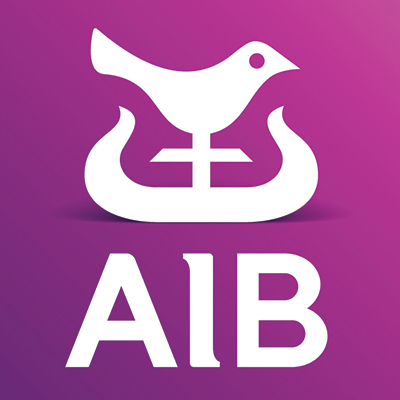
FINANCIAL REPORTING
Financial Reporting News
Financial Reporting News
The proposals are based on amendments issued by the IASB in May 2023.
Comments on FRED 84 were due 31 December 2023.
The FRC expects to finalize the proposed amendments in the first half of 2024, alongside the amendments arising from the current periodic review of FRS 102 and other FRSs.
CPA Ireland responded to FRED 84.
The report highlighted capacity constraints, recruitment and retention challenges, alongside regulatory requirements, as the main obstacles for smaller firms looking to expand their presence – especially in audits of public interest entities (PIEs).
To promote greater competition and choice in the audit market, the FRC has highlighted the importance of a collaborative, cross-system approach involving the regulator, audit firms, professional accounting bodies, and government. The FRC itself has already launched initiatives like Scalebox to help smaller firms understand regulatory standards and grow their PIE audit capabilities.
Audit firms are encouraged to prioritise cultures that better support their staff, including training and resources, while professional accounting bodies should continue efforts to attract new talent into the profession and maintain high auditing standards. Government can also play a role with policies that encourage competition and innovation in the audit market.
The summary indicates:
- The impact of climate change and climate impact mitigation initiatives on companies. This reflects the focus of IAASA on the financial reporting implications of climate change and climate commitments by companies.
- The adoption of European Sustainability Reporting Standards (ESRSs) across Europe on a phased basis from 2024 (ie financial year 2024, with sustainability reporting first being published in 2025) will dramatically impact environmental reporting requirements for companies; and
- That, in general, the level of compliance by companies with financial reporting requirements continues to be strong.
A summary of the report can be found here.
The podcast focusses on two of the Committee’s discussions about:
- Climate-related commitments in IAS 37 Provisions Contingent Liabilities and Contingent Assets; and
- Disclosure of revenues and expenses for reportable segments in IFRS 8 Operating Segments.
Irish Accountancy Sector by Mark Butler
“We’re always on the trail of finding suitable partners who would like to join us. John was 30 years in business and has a similar client base working with privately owned businesses. ‘John, like us, believes that clients should always have access to a partner and an advisory practice is built on the personal relationships forged with clients. Therefore, culturally they were a perfect fit to join us.
“We are focused on ambitious growing entrepreneurial led businesses,” he added.
Technology, he said, was allowing HLB Ireland to strengthen its relationships with clients. “Traditionally business needed an accountant in-house, and then we dealt with historic information predominantly for compliance purposes.
The right technology and having an advisory mindset is changing the focus of these relationships and we can now be much more hands on in assisting and providing much more timely current information which facilitates us being in a better position to advise our clients, and this approach also reduces risk for businesses.”
The traditional mindset of accountancy firms is focused on building enduring relationships; within our experience, these trusted relationships can last decades. We have recognised that in order to maintain and grow these relationships into the future, investment in technology for focused service delivery is essential. Additionally, being in a position to focus on advisory across our full range of clients along with services such as Cyber Security, Wealth Management, ESG and Sectoral expertise, will be critical into the future as client needs and indeed competition continues to evolve.
The global accountancy sector is experiencing a wave of consolidation, driven by factors such as technological advancements, regulatory changes, succession challenges and the need for firms to enhance their service offerings. Larger firms are seeking to expand their market share and capabilities by merging with or acquiring smaller, specialised firms.
Digital Transformation:
The traditional model of individual client acquisition is giving way to a more interconnected, leader- and specialist-driven model. Embracing digital tools and diverse distribution channels has become essential for accountancy firms to stay competitive.
Talent Acquisition and Retention:
Attracting, securing and retaining talent, spanning from recent graduates to seasoned professionals, presents an enduring challenge for firms of varying sizes. The traditional model of structuring an accountancy practice is changing, partly I believe, to try deal with the talent shortage and to continually attract a high calibre professional to practice.
Private Equity:
The accountancy sector has witnessed a notable surge in the influence of private equity, as an increasing number of firms have been acquired by consolidators or firms, some of which are private equity backed. To date in Ireland these are generally UK-based entities. This trend reflects a dynamic shift in the professional services landscape, as private equity firms recognise the strategic value and potential profitability within the accountancy sector. The infusion of private equity investment brings not only financial backing but also a drive for operational efficiency and strategic innovation thereby disrupting the traditional model. This growing trend of acquisitions by UK parties underscores a transformative phase for those accountancy firms, as they navigate new partnerships and ways of working.
1. Cultural Alignment in Mergers:
Cultural alignment takes centre stage in the intricate process of merging firms, demanding a prioritised focus to orchestrate a seamless transition and foster harmonious collaboration. The success of any merger hinges significantly on the compatibility of firm cultures and the resonance of shared values. This emphasis on cultural synergy is particularly critical in Ireland, where the close-knit nature of the business community places a premium on relationships and shared values. Here, the interconnectedness of professional and personal networks amplifies the significance of aligning cultures, creating a foundation for enduring success.
2. Client First Approach:
Engagement and expertise are crucial factors for clients who wish to build trusted relationships with professionals who have the advisory skill set to help them grow their business and indeed for professionals seeking to build their careers. It is therefore critical that there is this alignment evident for the long term in building these client relationships post merger.
3. Strategic Mergers for Growth:
Younger professionals in the Irish accounting profession are increasingly aware of their career progression options and the potential impact mergers have upon their career trajectory. Merging with the right firm is seen as a strategic move to enhance career prospects, leverage a broader client base, and access additional resources. Access to an international network is key to forward thinking firms keen to ensure they retain clients as they in turn need access to global support. International accounting networks serve as invaluable platforms, facilitating cross-border knowledge exchange among firms, enabling them to learn from each other’s diverse experiences and insights along with aligning strategies for growth.
1. Leadership Cultivation:
In professional services firms, the cultivation of effective leadership is paramount to ensure that leaders are optimally positioned to navigate and serve the evolving needs of the firm in the future. Leadership development programs should be thoughtfully designed to hone the skills required in the dynamic landscape of professional services. This involves fostering strategic thinking, adaptability, and a deep understanding of emerging industry trends. Cultivating a culture of mentorship and continuous learning further contributes to leadership excellence. In the face of technological advancements, global complexities, and shifting client expectations, leaders must be equipped with the ability to inspire innovation, foster collaboration, and drive sustainable growth. By prioritising leadership development, professional services firms can fortify their resilience and readiness for the challenges and opportunities that lie ahead.
2. Segmentation:
To drive ongoing growth, a clear view of your market is important to ensure real meaningful engagement with that target audience. Segmentation by industry is an approach forward-thinking firms have adopted and, in turn, have built deep expertise in key sectors with a view to being the top-of-mind option in their field. This approach builds a deep understanding of evolving client needs in specific industry segments. In our experience and the experience of professionals adopting this approach, this focus yields results beyond the specific segments focused upon and elevates the firm’s profile as a true expert. Market segmentation is crucial for efficiently allocating scarce resources and time, allowing firms to tailor their efforts to specific client segments strategically.
3. Three Essentials for Strategic Growth:
Sophisticated marketing, evolved pipeline management, and innovative service development form the three essentials for strategic growth. The synergy of sophisticated marketing, evolved pipeline management, and innovative service development surpasses the impact of each individual component, marking these three essentials as a formidable force for strategic growth. Together, they constitute the cornerstone for navigating the dynamic terrain of the accounting sector. The harmonious balance of these elements not only ensures a comprehensive strategy but also forms a powerful alliance that propels sustained growth.
4. Pipeline Management and Business Development:
Integrating business development as a core requirement for professionals leading specific segments is crucial. Growth doesn’t happen accidentally. Firms focusing on effective pipeline management for both recurring revenue and project work tend to maximise opportunities, aligning business development strategies with the growth objectives. Fundamentally it is important to understand the source of inbound valuable referrals so they can be built upon.
5. Recruitment of Multifaceted Leaders:
Accountancy firms should actively recruit leaders with additional skills to core technical requirements, including business development and innovation. The ability of professionals to be willing and open to widen their skill base ensures a firm’s agility and adaptability in a rapidly changing environment.

Embracing change and investing in the right talent, technologies and new services are essential for navigating the challenges and opportunities that lie ahead, ensuring sustained success for accountancy practices in the future.
Mark Butler can be contacted directly and in confidence at mbutler@hlb.ie

Mark Butler, managing partner of HLB Ireland has led the firm through a number of mergers in recent years, most recently with John McCarrick & Associates, an accountancy firm founded in 1990 by former Irish international runner John McCarrick. The deal is the fifth transaction HLB Ireland has been involved in so many years as it continues to scale the firm.
Don’t Defer your Tax Accounting by Dympna Cassidy and Brian Murphy
In practice, deferred tax creates many questions when the guidance is being pragmatically applied to various situations. For example, International Financial Reporting Standard (“IFRS”) reporters noted some challenges in interpreting how deferred tax should be applied to leases when the new IFRS leasing standard was issued. To address the diversity in practice, the International Accounting Standards Board (“IASB”) had to issue a narrow scope amendment to IAS 12. The accounting for deferred tax also receives quite a lot of scrutiny from external auditors, internal decision-makers and accounting regulators alike.
The accounting for deferred tax in your accounting records requires an understanding of the core concepts. From an FRS 102 perspective, some examples include deferred tax liabilities, deferred tax assets, sufficient future taxable profits, taxable and accounting profits, substantially enacted rates, and permanent and timing differences. There are also heightened considerations concerning the recognition and measurement of deferred tax assets due to recoverability considerations and specific rules around discounting and the offsetting of deferred tax assets and liabilities. The successful accounting for deferred tax requires not only a knowledge of the core definitions, but also the exceptions in conjunction with an in-depth knowledge of the guidance for specific balances, for example, business combinations. Topical areas such as Pillar 2 and the impact of climate-related risks on entities also create bespoke deferred tax considerations for companies.
Getting your deferred tax accounting correct is not only salient from the perspective of presenting appropriate statutory financial statements, but also from the perspective of reducing volatility within the financial statements. It also assists FRS 102 reporters in understanding future obligations to pay taxes that are based on profits that have already been earned. This ultimately supports the management of cashflows associated with taxes and signposts the quantum of cash that is needed to pay tax bills once the deferred tax becomes current tax.
A deferred tax liability is defined in the glossary of FRS 102 as income tax payable in future reporting periods in respect of future tax consequences of transactions and events recognised in the financial statements of the current and previous periods. So it reflects a future outflow payable by the entity. On the other hand, a deferred tax asset reflects a future tax deduction i.e. a benefit to the entity. Section 29 of FRS 102 defines them as income taxes which are recoverable in future reporting periods in respect of:
- future tax consequences of transactions and events recognised in the financial statements of the current and previous periods;
- the carry forward of unused tax losses; and
- the carry forward of unused tax credits.
The threshold for recognition of a deferred tax asset is higher than a deferred tax liability. Prior to the recognition of a deferred tax asset, an entity must ensure that there are sufficient future taxable profits against which the deduction can be recovered. An entity is required to challenge itself by assessing whether it is considered probable that it will have sufficient taxable profits available in the future to enable the deferred tax asset to be recovered. There is also emphasis placed on “probable” which is defined in the glossary of FRS 102 as “more likely than not”. Unrelieved tax losses and any other deferred tax assets can only be recognised to the extent that it is probable that they will be recovered against the reversal of deferred tax liabilities or other future taxable profits. The fact that there are unrelieved tax losses in the first instance is strong evidence that there may not be other future taxable profits against which the losses will be relieved.
When it comes to the assessment of whether a deferred tax exists at the year-end that needs to be captured in the statutory financial statements, Section 29 requires a “timing difference plus” approach to be taken. Timing differences occur when there is a difference between the accounting and taxable profit or loss. Accounting profit or loss is the amount calculated using an accounting basis i.e. FRS 102, and is the amount presented in a company’s profit or loss or total comprehensive income. The taxable profit or loss is the amount for a reporting period upon which income taxes are payable or recoverable, determined in accordance with the rules established by the taxation authorities. As a result, there can be differences between the accounting and tax profit or loss which can cause a timing difference.
The “timing difference plus” approach requires deferred tax to be recognised on all timing differences, however, there are a number of exceptions to this. For example, unrelieved tax losses and other deferred tax assets, as mentioned earlier, can only be recognised to the extent that it is probable that they will be recovered either against the reversal of deferred tax liabilities, or other future taxable profits. In addition, no deferred tax is recognised on permanent differences, for example, a grant which is not subject to tax or an expense that is disallowable for tax purposes. There is however an exception to permanent differences relating to business combinations. Again, this re-emphasises the need not only to be familiar with the core definitions in Section 29 but also the exceptions . The “plus” in the “timing difference plus approach” refers to the required recognition of deferred tax on asset revaluations and on assets (except goodwill) and liabilities arising on a business combination.
Applying these core concepts to a simple example, let’s assume the following:
Company A, which has a year-end of 31 March 20XX operates a defined contribution plan for its employees. The Company pays the annual charge for the plan in advance and tax relief is provided on the plan in the accounting period in which the payment is made. As the contributions have been paid in advance, the tax relief is greater than the expense recognised in the profit and loss account for accounting purposes. This is because the advance payment for accounting purposes is recognised as a prepayment and released to the profit and loss account over time, however, the full tax deduction was allocated when the annual charge was made. In the following period, the financial statements will have those advance contributions charged as an expense, but no tax relief will be available. This is a timing difference which would result in a deferred tax liability.
Some other salient technical considerations pertaining to deferred tax include, but are not limited to, discounting what rate is used to calculate deferred taxes, and the offsetting of deferred tax assets and liabilities. It should be noted that the discounting of deferred tax assets or liabilities is prohibited applying Section 29 of FRS 102. This is helpful from a practical perspective as, if required, this would create complexities and require detailed schedules to understand the expected timing of reversals.
Section 29 also requires the application of a substantially enacted tax rate. There are also additional considerations in relation to the tax rate applied in the calculation of deferred tax, for example, concerning profits affected by distributions and balances such as investment property which is recognised and measured using the revaluation model.
The offsetting of deferred tax assets and deferred tax liabilities is permitted only where certain conditions have been met. Specifically, the entity must have a legally enforceable right to set off current tax assets against current tax liabilities. They also must relate to income taxes levied by the same taxation authority on either the same taxable entity or different taxable entities which intend either to settle current tax liabilities and assets on a net basis, or to realise the assets and settle the liabilities simultaneously in each future period in which significant amounts of deferred tax liabilities or assets are expected to be settled or recovered.
For those with group members applying both IFRS and FRS 102 it should be noted that there are distinct differences in the approach outlined in Section 29 of FRS 102 requiring a “timing difference plus” approach rather than the “temporary differences” approach as outlined in IFRS’s equivalent income taxation standard IAS 12. In terms of detail, whilst the standards are fundamentally different, generally, you would expect the FRS 102 approach to give the same answer as the IFRS one. Other areas of difference include convertible debt and business combinations.
Interestingly, FRED 82 brings quite significant changes to FRS 102 including greater alignment with IFRS on some core topics, however, it does not address deferred tax. Section 29 remains broadly unchanged with the exception of the inclusion of inserted guidance about uncertain tax positions. As a result, the core differences between IFRS and FRS 102 on the topic of deferred tax will continue to exist after FRED 82’s effective date of 1 January 2026.
Overall the application of the guidance in Section 29 of FRS 102 in relation to deferred tax requires a knowledge of the core terms in conjunction with the exceptions and specific rules on certain topics. It has a far reach over your financial statements as any balance with timing differences has the potential to create a deferred tax impact.


Deloitte Ireland LLP
Taxation News
Taxation News
There are 3 important changes that will apply to Irish traders:
- Pre-notification requirements for live animals, animal products and high and medium risk category plant products;
- Full customs controls;
- Health certification on medium risk animal products, plants, plant products and high risk food and feed of non-animal origin.
The new rules will impact you if you export goods to Great Britain or via the UK landbridge to the rest of Europe.
Approximately 275,000 of the returns filed to date resulted in an overpayment of tax.
Among the key tax credits and reliefs claimed by PAYE taxpayers are the rent tax credit and health expenses. Revenue also reminds PAYE taxpayers that they need to tell Revenue about any additional income which has been earned outside the PAYE system.
2023 saw record tax receipts with Revenue collecting €87.2 billion in taxes and duties for the Exchequer. In addition, Revenue collected over €26 billion on behalf of other Departments, Agencies and EU Member States.
The record receipts for 2023 was underpinned by high timely compliance rates across all taxes. This reflects very positive engagement by businesses, individual taxpayers and agents with their tax compliance obligations. Revenue supports this culture by providing a wide range of services to make it as easy as possible for taxpayers to pay the right amount of tax at the right time, while also confronting and tackling non-compliance in all its forms.
The identification, targeting and disruption of shadow economy and other illegal activity such as smuggling, continues to be a key focus for Revenue.
In 2023, Revenue seized almost 70 million cigarettes valued at over €55 million, and a record breaking 9,085 kilos of drugs with an estimated value of almost €302 million.
Tax and Duty Manual – Taxation issues for Registered Farm Partnerships- has been updated as follows:
- To reflect an increase to €20,000 in the maximum cash equivalent of relief a partner is entitled to receive over a 3 year period.
- To include new content at section 2.1.2. regarding Regulation (EU) No.1408/2013 which deals with de minimis aid in the agriculture sector and sets out the maximum de minimis aid available to any individual farmer.
Tax and Duty Manual – Tax credit for succession farm partnerships has been updated to provide for an increase in the maximum amount of relief that may be granted under sections 667D (relief for succession farm partnerships) and 667D(stock relief) TCA 1997 and under section 81AA SDCA to €100,000.
Determining Employment Status by Mairéad Hennessy
When comparing employed versus self-employed status, there are several distinctions to consider, which include differences in rights, responsibilities, and tax implications.
The following checklist provides some of the considerations in determining whether an engagement is an employment or self-employed arrangement. The below list is not exhaustive, and every case should be considered on its own merits.
Overturning the Court of Appeal, the Supreme Court has determined that the delivery drivers of Domino’s Pizza were employees and not independent contractors.
This case has received a lot of attention over the last few years and its decision is very significant to employers. In its judgment the Supreme Court has clarified the position with regards to workers who fall within the legislative interpretation of the “employee” definition by setting out a five-step test to determine whether a contract is one of service or for services, although the underlying historical tests remain valid.
- Karshan produced and delivered pizzas and ancillary food items to customers, who placed orders by telephone, the internet and attending its stores.
- Karshan engaged drivers to deliver the pizzas to its customers.
- Each driver entered into a written agreement with Karshan, which outlined the company’s need to sub-contract the delivery of pizzas, as well as the promotion of its brand logo, and that the driver (referred to in the agreement as the “contractor”) would be willing to provide those services.
- The agreement stated that the driver would be retained as an “independent contractor” and that the company had “no responsibility or liability whatsoever for deducting and/or paying PRSI or tax on any monies [he/she] may receive under this agreement”.
- Each driver was required to provide his/her own delivery vehicle in a roadworthy and safe condition and to insure same for business use. Alternatively, the driver could rent such a vehicle from Karshan, with the agreement stating that the company was also prepared to offer third-party insurance at a predetermined rate. (TAC found no evidence that company vehicles were available for the drivers to rent).
- Drivers were also required to wear a fully branded uniform (subject to checks by store managers), with a deposit requested by the employer from the drivers for same.
- The driver could engage a substitute provided the substitute could undertake all of the driver’s contractual obligations, with the substitute being paid by Karshan.
- On a shift, drivers clocked in and out using a computerised system located on Karshan’s business premises and were given a cash float by the company, which was returned at the end of the shift.
- Drivers were required to use their own phones when contacting customers. The company also limited the number of pizzas that could be delivered to two per time, and some drivers folded boxes while waiting for deliveries, often at the request of the store manager.
- The contract envisaged that invoices would be prepared and submitted to Karshan by the drivers, but it was found that not all drivers prepared such invoices. Karshan would prepare invoices for many (but not all) of the drivers that would then be signed by the relevant driver.
The Appellant, the Revenue Commissioners, argued at all times that they were employees retained under contracts of service.
The dispute has a long history commencing with a TAC decision which held that the drivers were employees. This was upheld by the High Court but overturned by the Court of Appeal. The Court of Appeal was of the view that there was no mutuality of obligation between the drivers and Karshan and as such, they were independent contractors.

- The mutual commitments had to present some type of continuity (“continuity”)
- They had to have a forward-looking element (“extending into the future”)
- There had to be an obligation on the part of the employer to “provide” work
- There had to be an obligation on the part of the employee to “perform” work
Karshan argued that without mutuality of obligation, a contract of service could not exist.
The Supreme Court maintained that the mere fact that an individual does not owe any contractual obligation to an employer when they are not working, does not preclude a finding that the individual is an employee, at the times when he/she is working.
In the end, the Supreme Court dismissed the argument that an agreement cannot be classified as a contract of employment unless there is the mutuality of obligation outlined by Karshan. It stated that this reasoning relied on adding a new, arbitrary requirement to the employer-employee relationship that has no basis in principle and is not backed by authority.
In this decision, the Supreme Court primarily considered whether mutuality of duty is a necessary need for the establishment of an employment contract. The Supreme Court disagreed, confirming that mutuality of responsibility is a significant consideration for determining employment status rather than a necessary condition for the existence of an employment contract.
- Does the contract involve the exchange of wage or other remuneration for work?
- If so, is the agreement one where the worker agrees to provide their own services, and not those of a third party, to the employer?
- If so, does the employer exercise sufficient control over the supposed employee to render the agreement one that is capable of being an employment agreement?
- If requirements 1-3 are met, the decision maker must then determine whether the terms of the contract between employer and worker and the reality of the working arrangements are consistent with a contract of employment, or whether they point to some other form of contract.
- Finally, it should be determined whether there is anything in the particular legislative regime under consideration that requires the court to adjust or supplement any of the foregoing.

The Supreme Court ruled that the evidence showed specifics of Karshan’s previously stated “close control” over the drivers while they were at work. Noting that there were some features of the activities carried out by the drivers that were consistent with their being independent contractors engaged in business on their own account.
The Supreme Court noted that the TAC was entitled to conclude that the evidence pointed to the drivers carrying on Karshan’s business rather than their own, and they were employees of the company for the purposes of the relevant provisions of TCA 1997, having regard to the satisfaction of the established tests.
This could be largely attributed to:
- the requirement for the drivers to provide notice of availability;
- the inability to freely provide a substitute in the event of an inability to work;
- the requirement for the drivers to wear the branded clothing of Karshan (furthering the promotion of its brand); and
- the lack of negotiating power held by the drivers in respect of their contracts.
Separate to updating of the Code, Revenue will shortly issue guidelines on the judgement and its impact on the employment status of individuals for tax purposes.
The Supreme Court’s revision and restatement of law on this topic provides clarity for businesses who wish to engage workers as independent contractors in the gig economy, reiterating the risk that these organisations may end up liable for payment of employment related taxes and social contributions, regardless of the wording included in a contract.
It is important that businesses which engage contractors review how each such arrangement operates in practice and ensure the relevant contracts reflect this reality.

Employer Reporting of Benefits by Jane Quirke & Clare Fitzgerald
There are three categories of non-taxable items, which are currently in scope for reporting: travel and subsistence, the small benefit exemption and the remote working daily allowance.
- Enhancement of Revenue’s compliance framework.
- Diversion of resources and contacts away from compliant employers.
- Providing increased visibility and assurance to employees that their income is being reported Properly to Revenue.
- Provision of meaningful and effective high-level data to the Department of Finance.
In practice employers reimburse expenses, weekly, bi-weekly or monthly and small benefits may be provided on an ad-hoc basis. Revenue must be notified “on or before” any reportable item is provided to employees and directors which therefore creates a very onerous requirement for employers.
The date the payment is made, or the date the small benefit is provided to employees and directors is the relevant date for determining what reportable items are in scope.

- Remote working allowance of €3.20 per day;
- Small benefit exemption; and
- Travel and subsistence.
Remote working allowance
The remote working allowance, of up to €3.20 per day, which employers can pay to employees for each day worked from home (subject to conditions).
Travel and subsistence
Payments by employers to employees to reimburse business related travel and subsistence costs including:
- Vouched travel and subsistence
- Unvouched travel and subsistence e.g. civil service mileage rates
- Country money
- Emergency travel
- Eating on site allowance
Small benefit exemption
Vouchers or benefits provided to employees that come within the ‘small benefit exemption’ regime i.e. currently, up to two small benefits each year that do not exceed an aggregate value of €1,000.
- By file upload through ROS. The ROS ERR system can only accept JSON or XML file formats. Employers must ensure that their returns are in the correct format and that the files include all required data, to ensure the files upload to ROS successfully;
- Manual entry of relevant details on ROS via the specific ERR portal; or
- Using a software package that files directly to ROS e.g. an add-on to an existing payroll software or expense software.

- Engage with all relevant internal stakeholders so as to determine who is responsible for ERR filings.
- Review the data required for ERR submissions and determine how it can be extracted in an appropriate reporting format. In small organisations one person may hold all of the data required for ERR, however in larger organisations data may be managed by multiple teams outside of the payroll process, for example, by HR, finance or by a separate expenses team.
- Review where employee data is maintained. If reporting is done via payroll, then employee data required for ERR submissions should be held on payroll software. However, where reporting is done outside of the payroll process, employers need to put in place a mechanism to merge employee data with the other reportable ERR data.
- Review policies to ensure they align with tax legislation and Revenue guidance. Analyse data before Revenue does and consider whether any policy changes are required including any retrospective non-compliance which may need to be addressed via a self-correction or voluntary disclosure.
- Review controls in place to track all non-cash benefits provided to employees. Under the small benefit exemption, if more than two benefits are provided in a tax year, only the first two may qualify for exemption.
- Determine how reporting will be done i.e. via payroll software supplier, expenses software supplier or manually.
- Consider whether current expense payment timeframes need to be amended, for example, where an employer has an on-demand expense payment policy, it may be beneficial to change to a more structured process to reduce administration.
Are travel and subsistence paid directly by the employer to a third party in scope for ERR reporting?
Expenses paid directly by the employer to third parties e.g. hotels or travel provider, in relation to business travel expenses are not currently in scope for ERR reporting.
For a reporting requirement to arise under ERR in relation to travel and subsistence, the employer must reimburse the employee for the travel expenses incurred by the employee. Travel expenses incurred on company credit cards and settled by the employer are not in the scope of ERR reporting.
Do per diems fall under the reporting?
Yes. Daily allowances paid to employees (e.g. civil service subsistence rates) fall under travel and subsistence. They are therefore in-scope for ERR and are reportable.
Such expenses should be reported under the ‘Unvouched travel and subsistence’ category.
If travel expenses are reimbursed for a Director who is not paid a salary and hence not on payroll, does this fall within the scope of ERR reporting?
ERR applies to directors and employees. The payments of travel and subsistence paid to directors are reportable under ERR even where the director is not on payroll i.e. as no remuneration other than tax-free subsistence is paid.
Is a correction facility available for ERR submissions?
A correction facility is available if incorrect details are reported i.e. individual expense/benefit line items can be amended or deleted. Further details and examples of how specific corrections can be made are available on Revenue’s website.
Are receipts required when reporting ERR?
Receipts are not required as part of an ERR submission. However, employers are expected to keep robust records in support of non-taxable payments.
That administrative burden is only likely to increase in the future as Revenue have confirmed that ERR is just “phase one” of a phased introduction of additional reporting for employers so we can expect further items to fall within the scope of reporting in the future.
It is clear that the area of payroll tax compliance has become a key focus area for Revenue.
ERR will provide Revenue with increased visibility of non-taxable items being paid to employees on a real time basis along with data capable of being used for risk-profiling purposes and analysed by Revenue during the course of payroll tax compliance interventions. We are therefore likely to see more focused payroll interventions on these non-taxable items going forward.

Jane joined Grant Thornton in 2011 having previously worked as a tax manager of a Big Four firm. She has worked both in Ireland and abroad having worked for a Big 4 firm in the UK where she specialized in global employment tax.

She also has experience in providing tax advisory and compliance services to individuals.
In Practice News
Per Bye Law 15, a designated person is;
“The Institute of Certified Public Accountants in Ireland (the Institute) is a competent authority under S.60 of the Criminal Justice (Money Laundering and Terrorist Financing) Act 2010 as amended, (the Act) and is responsible for the supervision of its members and Firms who are considered to be designated persons under the Act.
A member or firm is considered to be a designated person only in respect of those activities or services that render the person a designated person. Typically for the purposes of a member of the Institute such services include audit, external accountancy, tax adviser, trust or company services.”
For further information regarding AML, please consult CPA Ireland’s AML technical resource. This acts as a central point bringing together all guidance in a single location, to assist firms. It is a live resource which is regularly updated as new guidance is published.
The ISA for LCE: An Overview
The ISA for LCE is not just an amendment or an addendum; it is a new standalone global auditing standard. Build on the foundation of the globally well-respected and widely adopted International Standards on Auditing (ISAs), it aims to provide the same level of assurance: reasonable assurance, for eligible audits. The significance lies in its proportionate and tailored approach to the unique audit needs of less complex entities.
This new standard addresses the challenges faced by auditors that audit less complex entities, recognizing the focused expectations stakeholders have for an audit of a less complex entity. By doing so, the ISA for LCE aims to enhance confidence in financial reporting and promote global consistency in applying auditing standards to these entities, thereby reducing the risk of jurisdictional divergence.
The ISA for LCE is set to be effective for audits of financial statements of less complex entities starting from December 15, 2025, with early adoption permitted.However, before the standard can be used in jurisdictions, each jurisdiction must decide whether to adopt it.
The introduction of the ISA for LCE marks a pivotal moment in the evolution of auditing standards, catering specifically to the needs of less complex entities. As jurisdictions consider its adoption, the global accountancy profession eagerly anticipates the positive impact this standard will have on audits of small and less complex businesses worldwide.
The good news is not to worry as we are here to help!
In the year 2022, 70% of all firms reviewed, received a satisfactory grade.
Here are some valuable tips to help you feel less stressed in the lead up to your review and achieve that satisfactory grade.
- ISQM 1
- CPD Requirements for statutory auditors
- Audit Procedures
- Audit Evidence and Documentation
- Key Issues Identified in QA Reviews 2022
- Quality Assurance Website
- Technical Queries
- Quality Assurance Executive
Communication with those Charged with Governance (TCWG) by Phyllis Willoughby
- Executive and non-executive directors
- Members of an audit committee where on exists
- For other types of entity, it usually includes equivalent persons such as the partners, proprietors, committee of management or trustees
- For smaller entities this is usually the owner-manager where there are no other owners
- The forming and expressing of the audit opinion on the financial statements that have been prepared by management with oversight of those charged with governance.
- The planned scope and timing of the audit.
- The significant findings from the audit.
- Planning matters are often communicated early to TCWG in the audit engagement.
- It may be appropriate to communicate a significant difficulty encountered during the audit as soon as practicable to TCWG who are then able to assist the statutory auditor in overcoming the difficulty.
- The size, operating structure, control environment and legal structure of the entity being audited.
- Any legal obligation to communicate certain matters within a specified timeframe.
- Communications regarding independence may be appropriate whenever significant judgments are made about threats to independence and related safeguards, for example when accepting an engagement to provide non-audit services.
- The appropriateness and timeliness of actions taken by those charged with governance in response to matters raised by the statutory auditor.
- The apparent openness of TCWG in their communications.
- The apparent ability of TCWG to fully comprehend matters raised during the audit process.
- Difficulties in establishing with TCWG a mutual understanding of the form, timing and expected general content of communications.
- Where TCWG are involved in managing the entity, their apparent awareness of how matters discussed with the statutory auditor affect their broader governance and management responsibilities.
- Whether the two-way communications meet applicable legal and regulatory requirements.
- Any changes in accounting policies that materially affect the financial statements.
- Material events or uncertainties which impact going concern and require disclosure in the financial statements.
- Material weaknesses discovered in the internal systems and controls.
- Any expected audit report modifications.
- Adjustments arising as a result of audit procedures which could materially impact the financial statements.
- How the statutory auditor plans to address significant risks of material misstatement, whether due to fraud or error.
- The nature and extent of specialized skill or knowledge needed to perform the planned audit procedures or evaluate the audit results, including the use of an auditor’s expert.
- Details of any threats to independence and objectivity, including safeguards applied.
- Recommendations, where relevant, to help improve the entity’s internal systems and controls.
Top ten practical steps the statutory auditor can implement to strengthen compliance with ISA (Ireland) 260 when carrying out statutory audits.
- Strategic decisions made that significantly affect the nature, timing and extent of audit procedures.
- The suspicion or detection of fraud.
- Concerns with integrity or competence of senior management.
- Written communications such as letters of engagement, audit planning letters, audit findings letters, minutes of meetings, memo’s placed on audit file etc.
- Verbal communications supported by minutes of meetings held.
- Virtual communications supported by recordings of virtual zoom and/or Microsoft teams meetings.
As discussed within this article there are various forms of communication, verbal, written, virtual etc., CPA Ireland have sample letters that will assist with communications with TCWG, these include:
- Audit engagement letters
- Audit planning letters
- Audit finding letters
These forms of communication can be found here.
IAASA published its key messages for auditors in the area of communication with TCWG, the link can be found here.

Digital Assets, Service Providers and Accountants by Ben Cronin
- What are Virtual Asset Service Providers (VASPs) and why are they relevant for accountants?
- What are the main accounting challenges related to digital assets?
- What are the common questions and resources for accountants in the digital asset space?
- Exchange services between virtual assets and fiat currencies or between different types of virtual assets;
- Transfer services of virtual assets;
- Safekeeping or administration services of virtual assets or instruments enabling control over virtual assets;
- Participation in and provision of financial services related to an issuer’s offer or sale of a virtual asset.
VASPs are subject to various regulatory requirements in Ireland, as they fall under the scope of the Criminal Justice (Money Laundering and Terrorist Financing) (Amendment) Act 2021, which transposed the Fifth EU Money Laundering Directive (5MLD) into Irish law. VASPs are required to register with the Central Bank of Ireland and comply with anti-money laundering (AML) and Counter Financing of Terrorism (CFT) obligations, such as conducting customer due diligence, keeping records, reporting suspicious transactions, and implementing policies and procedures to prevent and detect money laundering and terrorist financing.
The regulatory space surrounding digital assets is evolving at pace. In mid-June 2024, we will see the first phase of the Markets in Crypto-Assets Regulation (MiCAR) become applicable. MiCAR introduces a new regulatory framework for European crypto-assets and aims to protect consumers and investors and mitigate risks to financial stability. While the Financial Action Task Force (FATF)defines service providers as VASPs, MiCAR will cover Asset-Referenced Tokens (ARTs), E-Money Tokens (EMTs) and utility tokens and will require Crypto-Asset Service Providers (CASPs) to achieve authorisation to operate within the EU.
Accountants may be providing professional services directly to VASPs. VASPs should also be considered as a good source of information when providing services to clients that invest or trade in digital assets. Accountants need to have an understanding of the services provided by VASPs and the financial and reporting information that they hold.
- Considering the tax implications of transactions involving virtual assets, such as how gains or losses from cryptocurrency transactions are treated for tax purposes and ensuring compliance with tax regulations;
- Tracking and reconciling financial transactions involving virtual assets and fiat currencies, to ensure accurate financial reporting for individuals or businesses engaged in cryptocurrency activities;
- Valuing virtual assets for financial reporting purposes, which can be complex due to factors like market volatility and liquidity. Accountants may need to stay updated on industry best practices for valuing cryptocurrencies and other virtual assets;
- Accounting for virtual assets as investments, which may require fair value measurement and impairment assessments. Some entities may hold virtual assets as investments, either for their own account or on behalf of their clients;
- Managing the risks associated with virtual assets, such as market risk, operational risk, and regulatory risk. Accountants may contribute to identifying, assessing, and mitigating these risks, using appropriate tools and frameworks.
- Are gains from trading digital assets considered trading income or capital gains tax (CGT)?
- How do I figure out where the client stands from a tax perspective?
- Do I need an extensive knowledge of the crypto/digital asset space?
Trading Income or CGT?
According to the Office of the Revenue Commissioners, crypto assets are subject to income tax and CGT, depending on the type of transaction made. For example, if your clients trade crypto assets as part of their business, they will be subject to income tax at their marginal rate and may also have to pay social insurance contributions (PRSI) and universal social charge (USC). If your clients receive crypto assets as income, such as from mining, staking, airdrops, or rewards, they will also be subject to income tax.
If they sell or exchange crypto assets for a profit, they will be subject to CGT at a flat rate of 33%, after deducting any losses and the personal exemption amount of €1,270.
Some transactions are tax-free, such as buying crypto assets with EUR, holding them for long periods, or transferring them between your own wallets. However, you should keep records of all your crypto-asset transactions, as Revenue can track them and may require you to report them.
Determining Tax Positions
Determining the tax position and liabilities for your clients can be challenging, as they may have a considerable volume of trades across various crypto exchanges and wallets, and the value of the crypto assets may fluctuate significantly over time. Thankfully, there are service providers available that can help you with crypto-asset tracking and reporting, such as Koinly or CoinLedger. These services can trace and match every transaction on the blockchain and automatically calculate tax due, based on the Irish tax rules and rates. They can also generate tax reports and statements that you can use for filing and auditing purposes.
Crypto Wizard
You do not need to be an expert in the crypto/digital asset space, but you should have a basic understanding of the key concepts and principles, as well as the accounting and regulatory implications. You should also consult with your peers, mentors, or professional bodies for guidance and support.
- Buying crypto-assets with fiat currency, such as EUR, USD, or GBP, from a crypto exchange or a peer-to-peer platform;
- Selling crypto assets for fiat currency, either on a crypto exchange or directly to another person;
- Exchanging one type of crypto asset for another, such as swapping Bitcoin for Ethereum, or converting stablecoins to other cryptocurrencies;
- Receiving crypto assets as income, such as from mining, staking, airdrops, or rewards, or as payment for goods or services;
- Sending or receiving crypto assets as a gift, donation, or inheritance;
- Borrowing or lending crypto assets, such as using a crypto lending platform or a decentralised finance (DeFi) protocol;
- Investing in crypto assets, such as buying an NFT, a crypto fund, or a tokenised asset.
Crypto-asset transactions may not have a clear or consistent purpose or nature, as they may involve complex or innovative transactions, such as DeFi protocols, smart contracts, or tokenised assets, which may have different features, functions, and risks.
- The anonymity, pseudonymity, or lack of transparency of the transactions and parties involved, which may make it difficult to trace and verify the source and destination of the funds, the identity and location of the counterparties, and the purpose and nature of the transactions;
- The cross-border and decentralised nature of the crypto-asset ecosystem, which may expose your clients to different and inconsistent regulatory regimes and jurisdictions, and increase the complexity and uncertainty of the legal and compliance obligations;
- The technical complexity and innovation of the crypto-asset sector, may pose new challenges and threats to the security and integrity of the transactions and data and require constant adaptation and learning of the emerging trends and developments.
To manage the AML/CFT risks for your clients that deal in crypto-assets, you should apply a risk-based approach and take appropriate measures to mitigate the risks, such as:
- Conducting a thorough risk assessment of your clients and their crypto-asset activities, taking into account the type, value, frequency, and purpose of the transactions, the source and destination of the funds, the identity and location of the counterparties, and the level of compliance and oversight of the crypto-asset service providers involved;
- Verifying the identity and beneficial ownership of your clients and their counterparties, using reliable and independent sources of information, such as official documents, databases, or blockchain analysis tools;
- Monitoring and reviewing your clients’ crypto-asset transactions and activities on an ongoing basis, using appropriate tools and indicators to identify and flag any unusual or suspicious patterns or behaviours;
- Reporting any suspicious or unusual transactions or activities to the relevant authorities, such as the Financial Intelligence Unit (FIU) of Ireland, in accordance with the applicable laws and regulations;
- Keeping accurate and complete records of your clients’ crypto-asset transactions and activities, as well as the risk assessment and mitigation measures you have taken, for at least five years or longer if required by law or requested by the authorities;
- Educating yourself and your staff on the latest developments and trends in the crypto-asset sector, as well as the emerging risks and challenges, and updating your policies and procedures accordingly.
Compliance made easy with AML HQ
Our comprehensive platform includes all the tools accountants, bookkeepers, and tax advisory firms require to meet regulations and quickly onboard customers.
Get in touch or call our team on 01 485 3848 if you would like a free AML-health check or to learn more about how technology can help you meet your AML obligations.

Burnout in the Workplace by Edel Walsh
- Feelings of energy depletion or exhaustion.
- Increased mental distance from one’s job, or feelings of negativism or cynicism related to one’s job.
- Reduced professional effectiveness.
The symptoms of burnout can be physical, emotional, and behavioural. According to Leiter and Maslach (2005) symptoms can include:
- Being constantly overwhelmed, stressed, and exhausted.
- Change in sleep patterns.
- Passion has faded and has been replaced by negative cynicism.
- Loss of confidence.
- Nagging doubts about your self-worth.
If you are experiencing symptoms of burnout, I encourage you to speak to your GP or healthcare professional as a first port of call.
- Workload: where your workload might be too much, too hard, too urgent, or even too boring.
- Control: there may be a perceived lack of control where you have an inability to influence decisions that affect your role or the tasks you are doing.
- Reward and recognition: where you are experiencing problems with the reward and recognition you are getting from your job.
- Community: you might have difficult clients or feel undermined by your own colleagues and team members. Your manager micromanages you!
- Values mismatch: this is where your own personal values do not align with the values of your employer. This can increase stress levels.
For the employer, there is increased rates of absenteeism, greater attrition, lower engagement, and productivity.
According to a survey carried out by Gallup in 2020, where employees are experiencing burnout:
- They are 63% more likely to take a sick day.
- Half as likely to discuss performance goals with manager.
- 23% more likely to visit hospital.
- 2.6 times more likely to look for another job.
- 13% less confidence in their performance
If you feel you are experiencing burnout, it is time to act. Firstly, recognise the signs of burnout.
Then seek support. Speak to somebody about what you are experiencing. Take care of both your physical and mental health and consider the strategies for alleviating burnout.

Where you have too much work, firstly consider what is within your control to alleviate the problem. Consider in your daily routine, what tasks you can drop, delegate and delay? Any tasks that cannot be dropped, delegated, or delayed, should be actioned.
Where you are working long hours and your work is taking over your personal time, it is worth setting boundaries and learning to say “no”. If you find yourself consistently saying “yes” to more and more work tasks, ask yourself what you are saying “no” to. For example, if you are saying “yes” to working late, you may be saying “no” to your gym class or putting your kids to bed at nighttime. Often, if you are saying “yes” to work, you are saying no to yourself.
Leaders often encourage team members to take time off if they are overwhelmed with work. While that may be helpful in the short term, it does not get to the core of the workload problem. It is worth considering, what is the cause of workload problems among your team. What conversations can you have to support those team members. As a leader, what is within your control to solve these problems?
As a leader, if you lean towards micro-managing your team, it is worth considering the learning opportunities you are depriving them of by controlling their work. By giving more autonomy to your team there will be an upfront investment in your time and mistakes will be made. Mistakes are an opportunity for learning. This will free up your time in the long run allowing you to take on more stretch projects.
For leaders, you should give timely and effective recognition to all team members. Ensure time is put aside to praise and recognise the team, giving details as to what they have done that deserves recognition. Reward should go hand in hand with recognition.
When it comes to communication skills, take some time out and reflect on your own communication skills. I often hear clients say, “well he should know I can’t work late on a Wednesday as I have training”. In the words of George Bernard Shaw “The single biggest problem with communication is the illusion that is has taken place”.
When it comes to conflict resolution, there are lots of tools that can be used. A favourite of mine is “switching perspectives”. Take some time to reflect on the specific conflict from your own point of view. Then, switch perspectives and consider the conflict from the other persons perspective. Finally, consider what an independent third party would say about this conflict. This can help gain some clarity on the situation.
It is worth spending time getting clear on your values. Then, identify the values of the company you work for and your colleagues. It may become clear if your own personal values are misaligned with that of your employer.
Mckinsey & Company. (2023). What is Burnout. Available at: https://www.mckinsey.com/featured-insights/mckinsey-explainers/what-is-burnout
Gallup. (2020). Gallups Perspectives on Employee Burnout: Causes and Cures. Available at https://www.gallup.com/workplace/282659/employee-burnout-perspective-paper.aspx

BSc Finance, ACA, CTA
edel@edelwalsh.ie
Professional Branding for Women by Dawn Leane
There are many reasons for this; from the lack of female role models to generations of conditioning to be the ‘good girl’ and put the needs of others first, to the peculiarly Irish concept of making sure we don’t have ‘notions’ about ourselves.
But imagine this scenario; there’s a high-level meeting about forming a project team for an important assignment. Being part of this team would allow you to showcase your skills and experience, it would be a vote of confidence in your abilities, a significant achievement and would accelerate your career development.
This is a sought-after assignment. You aren’t in the meeting, but your manager is. Will they advocate for you? Will they do it with conviction? What will they say about you? In other words, can they represent your professional brand?
We all have a professional brand. It’s what people say about you when you’re not in the room. It’s how people introduce you, it’s how you introduce yourself. It’s also intangible; it’s how you make people feel. Most importantly of all, it’s your reputation.
A strong professional brand is key when the people in that room are decision makers, discussing issues such as secondments, promotions, key project teams and of course salaries.
When we don’t take ownership of our brand, we allow others to define it and that’s a very risky career strategy.
Career development is no longer all about industry expertise. It doesn’t matter how good you are at the ‘day job’, companies expect those skills as a baseline. There is a whole other set of behaviours and competencies that must be cultivated to ensure career success. These include strong social and communication skills, problem solving, networking, talent development and relationship building – among others.
Developing these skills is only part of the challenge, making people aware of them and ensuring that you are visibly demonstrating them is essential.

I’ve noticed the same issue and would add another behaviour that diminishes womens brands – the language they use to describe themselves. For the most part they use terms that describe tasks rather terms that describe impact.
For example, ‘I manage’ instead of ‘I deliver’. Women tend to use very mundane descriptions of their role ‘I’m responsible for…’ rather than I execute’.
Increasingly women are recognising the importance of a strong professional brand. After all, there’s no point in being the best at what you do if nobody knows it, or worse somebody else gets credit for it.
As Tom Peters puts it ‘We are CEOs of our own companies; Me Inc. To be in business today, our most important job is to be head marketer for the brand called You’.
Kaputa suggests that the main reason we don’t see more women at the higher levels of business is not because of a talent gap, but rather a self-promotion gap.
Picture the scenario again – this time imagine your manager saying, ‘I recommend her for the project, she has valuable experience in this area, excellent judgment and is a great consensus builder.’ Not only does it increase the chances of you achieving your seat at the table, but it also creates a strong first impression on your new colleagues – before they’ve even met you.
A professional brand statement is not a job description or a list of tasks. It’s about the added value you bring to the role, that other set of skills.
Begin by identifying the skills you want to build your brand around – are you a consensus builder? Maybe you have good judgement or perhaps your skill is identifying and developing talented team members. It’s crucial to understand your Unique Selling Point (USP).

Then begin to craft it into a statement, how will you introduce yourself in different scenarios? A sixty second networking introduction is very different to introducing yourself in a meeting. Your USP should remain unchanged, but you will have variants of your statement for different audiences.
This can be very difficult when faced with a blank page. I often suggest working with a thought partner; asking a friend or colleague to draft a first version for you to edit. Remember to elevate your language and focus on impact rather than tasks.
Unless you’re in a very technical interview, nobody cares what your tasks are.
While your brand will evolve as you develop new skills and experience, it’s crucial that your brand statement is authentic, and your behaviours are consistent with the brand you want to promote. As Carl Jung wrote You are what you do, not what you say you’ll do.
When it comes to communicating your brand, it’s important to learn how to accept positive feedback. All too often women are uncomfortable receiving praise and deflect it with comments such as ‘it was nothing’ or ‘it’s all part of the job’.
Replacing that response with a simple ‘thank you’ or ‘I appreciate that feedback’ communicates confidence and self-worth.
We convey our brand to others through the language we use, including words, tone and pace, whether we speak or choose to be silent. Women often diminish their message by apologising for themselves unnecessarily, using phrases such as ‘sorry to bother you’ or ‘I just wanted to…’
How do people experience your brand? Is it a first class or economy experience? Think of all touch points, the number of interactions you have every day, how do you either enhance or devalue your brand?
One of the most effective ways to communicate brand is simply to tell people what you’re about and in professional terms, your LinkedIn profile is the best way to do this. When someone hears your name in a professional context, the first thing they will do is checkout your LinkedIn profile.
If your page consists of the default background, a picture of you at a black-tie event and a sparse or non-existent profile statement, that sends the message that you’re not putting much effort in. Contrast that with a professional headshot, a well thought out personal statement and up-to-date, relevant posts, which creates an entirely different impression. And having no LinkedIn profile at all can raise a whole host of questions.
Carefully cultivated posts, replies and reposts are an opportunity to demonstrate your knowledge and expertise, positioning yourself as a subject matter expert. Make sure you do this with a little panache – differentiating yourself from others is key. Consider factors such as language or visual identity.
As Keith Ferrazzi, author of the networking bible Never Eat Alone, advises ‘Good personal brands do three highly significant things for your network of contacts. They provide a credible, distinctive and trustworthy identity. They project a compelling message. They attract more and more people to you and your cause, as you stand out in an increasingly cluttered world.’

Beyond Cybersecurity by Dr Rois Ni Thuama
The SolarWinds Scandal as a Reflection of Corporate Governance Failures
This article examines the material facts of this case and explains why this incident transcends a mere deficiency in cyber governance, indicating broader corporate failures hinting at significant corporate pain if we overlook the lessons from this matter.
The article also examines the SEC filings to capture the issues that the defendants are facing and provides clear instruction on how firms and their CISOs can avoid similar issues in the future.
There are three key takeaways from the short paragraph above.
Firstly, it is critical to understand SolarWinds (SW)’ offering to the market. The SW platform forms the core of their IT Management Portfolio providing a ‘stable and scalable architecture that includes data collection, processing, storage, and presentation.’ In other words, the executives in this firm are not without any understanding of how technology operates. This isn’t, for example, a company that manufactures lipstick.

Thirdly, the attack was attributed to a sophisticated nation-state actor. i.e Russia. However, this fact alone does not inherently imply anything about the complexity of the attack.
Historically, there has been a strong focus on determining the source of such attacks, with significant emphasis on discerning whether they were perpetrated by a nation-state or a criminal organisation. But from a technological standpoint, the nature of the actor is less consequential than the nature of the act itself. No company should be vulnerable to exploitation or attack due to a common vulnerability or exposure.
The emphasis on who initiated the attack is interesting from a geopolitical risk perspective, but not from a cyber governance, risk management or mitigation perspective. Ensuring that your business is fortified against known and significant threats is crucial, not only for maintaining cyber resilience but also for establishing a legally defensible position. Putting it simply, it’s not the actor, it’s the act.
It is likely that sophisticated and professional investors will increasingly look to recover for losses that might have been preventable. In the United States, for example, the business judgement rule shields a corporation’s director from liability in lawsuits alleging a breach of the duty of care to the company, provided the director’s actions meet the criteria of the rule.
It is elementary that directors in a technological firm appreciate the importance of making sound business decisions relating to their digital operational posture. After all, they must promote the success of their business, protect their firm, their clients and their reputation.
Directors in Ireland are subject to comparable responsibilities. Pursuant to Section 228 of the Companies Act 2014, a director is required to fulfil several duties, including acting in the best interests of the company, acting honestly in relation to the conduct of the affairs of the company, avoiding conflicts of interest, and demonstrating an appropriate level of care, skill, and diligence.
To what extent a director has exercised care, skill, and diligence will be considered against a two-stage test which contains both subjective and objective elements.
They are:
- the knowledge and experience that may reasonably be expected of a person in the same position as the director; and
- the knowledge and experience which the director has.
- Advertises its product as a ‘stable architecture encompassing data collection, processing, storage’ and
- Markets this product to entities classified under Critical National Infrastructure (CNI).
Given the givens, the bar is high. It would not be unreasonable to expect that any person holding a position of director and involved in the daily operations and management of a technologically sophisticated business would consider that in order to meet their legal obligations they would:
- Exercise reasonable care to ensure their own digital estate management is resilient, and
- Address reasonably identifiable circumstances to manage and mitigate risks to their business and their clients. In other words, they would recognise the importance of their business as a supplier to highly sensitive government agencies.
While these questions are not yet before the court, it is inevitable that businesses, on both sides of the Atlantic will find themselves defending their decisions and their decision-making process following cyber-attacks. Ultimately, this will be more painful in situations where the directors failed to fulfil their legal responsibilities, resulting in cyber-attacks that were preventable.
However, while it has been an intellectually stimulating exercise to speculate on potential outcomes, the current situation faced by the firm and its Chief Information Security Officer (CISO) offers a significant learning opportunity for businesses.
From a legal perspective, the presence of multiple false claims is significant as it indicates a pattern of conduct within the business. Had there been a solitary occurrence, it might have been capable of being construed as an error or oversight. However, a series of such incidents over a period of time evidences a continuity of purpose. This makes defending any genuine errors extremely difficult for the legal team.

This policy should expressly prohibit any employee from making statements about the business that are untrue or false. Declarations that statements are true together with notification of penalties for misleading the market could assist senior executives in appreciating the seriousness of making false claims.
Furthermore, it should be a standard expectation for executives to provide clear justification for their positions. For instance, if a technical executive, referred to as Executive A, makes a technological claim that is endorsed and propagated by the business across various departments (such as sales and marketing), there needs to be a transparent and traceable link from the claim’s originator to the final document. Importantly, this document should not be subject to alterations. Separate versions of the document should be preserved to document and track any modifications.

Given that it is well known and understood that strong passwords are a critical factor in keeping businesses safe and protecting them from cyber-attacks, it should be uncontroversial to implement best practice. Given that it is neither technologically difficult nor expensive to enforce, it is surprising that the firm failed to comply with even the most well-known, plain vanilla cyber security strategies.
The paramount lesson derived from the SolarWinds scandal is the widespread presence of dishonesty and duplicity within the organisation, indicative of a corporate culture that tolerates such behaviour. Attributing this to the corporate culture inherently implicates the leadership. Although the Chief Information Security Officer (CISO) is currently bearing the brunt, the ethical climate was established by the entire executive management. Such corporate failings are not a matter of technical inadequacies but rather a reflection of leadership deficiencies.

AI: Redefining the future of the accountancy profession by Harpal Singh and Laura Leka
AI offers vast potential to boost productivity and efficiency across various functions such as finance, procurement and supply chain, marketing, human resources, product development and design, risk management, manufacturing and operations, and customer engagement and sales.
To set the profession up for continued success, it is essential to understand the implications and opportunities AI presents.
With the growth in availability of data, and technological tools to transform data into useful information as well as meaningful insights for decision making, accountants can focus their attention on interpreting complex data, identifying the support that business operations need and tailoring internal and potentially external reporting for these purposes. Accountants who use these tools well will be more capable of supporting the business in making effective decisions across their organisations.
AI tools can process and analyze large data sets in real-time. This allows accountants to offer more sophisticated, value-added services. Predictive analytics, for instance, enables users to forecast future trends, identify potential risks, and provide strategic advice on financial planning and risk management. The profession is well placed to exploit these tools and embrace the benefits of this technology.
Internal and external reporting have historically had a focus on the past. While undoubtedly statutory obligations mean past results will always be important, there is necessity to act on current information and to utilize predictive tools to help gauge future possibilities through scenario analysis.
AI tools also offer great capability for tailoring advice, reporting and dashboards to the needs of organisations and clients. This can be a game-changer for small and medium-sized enterprises (SMEs) and small and medium-sized practices (SMPs).
Historically, such capability required either expensive in-house tool development or substantial admin time. In some ways, generative AI (in its freely available iterations at least) could therefore help level the playing field, as the ability to provide more nuanced, data-driven insights is increasingly becoming available to all, sometimes at little cost. At the same time, larger organisations will seek to exploit this technology through their ability to invest heavily in developing enterprise specific tools and through partnering with large organisations active in this space.
“Traditional” AI automates repetitive tasks and performs specific tasks intelligently based on a specific dataset – “pattern recognition”
- Classification – categorise input data into categories based on predetermined variables
- Prediction – Predict future events or outcomes based on historical data
- Optimization, trends/driver analysis, anomaly detection
Generative AI
- Generative AI assists in language-based tasks and creating content (text, images, music, computer code etc.) – “pattern creation”
- Summarisation/synthesis – generates summary of large volumes of text or other media
- Generation of content and translation
- Communication between a user and computer system
- Knowledge management – highlights information and insights embedded into all data types (docs, emails etc.)
- Automation of routine finance tasks – data entry, invoice processing, reconciliations
- Data analysis and forecasting
- Data modelling and scenario planning
- Market trend analysis
- Supply chain finance, optimizing working capital including through payment timing
- (Read more on how the digitalisation of procurement and supply chain operating models are changing the role of finance functions, see pages 10 – 12 of the IFAC report: Enabling purpose driven organizations)
- Tax planning through analysis of data against tax laws to identify potential savings and issues
- Evaluation of potential mergers, acquisition and other transactions through data analytics and broader assessments of strategic fit
For more examples and use cases of AI, click below
Accountants also play key roles as stewards of data and experts in processes and internal control, helping to ensure the reliability and accuracy of information.
Many professional accountants are already seeking training in data analysis and this pattern will likely grow in the future. Requirements in relation to computer literacy may experience similar growth and increasing specificity as AI literacy, prompt development and general technological adaptability become increasingly valuable.
Rapid advances in technology require a real commitment to continuous learning and adaptation from professionals, accounting firms and professional accountancy organisations. In many smaller organisations, individual accountants may be charged with ensuring the benefits of AI are being harnessed in their organisation, and this may be similar for practitioners in SMPs providing services for SMEs. This creates a responsibility to continually monitor and implement latest AI developments and best practice and interpret their implications for organisational processes. (Read more on The Uses of Artificial Intelligence for SMPs | IFAC).
The start of this journey to ongoing education is as much about developing a mindset open to innovation and change as it is about acquiring technological knowledge. Professional development programs will need enhanced focus on topics such as data interpretation, ethical AI usage and application of AI in strategic decision making. This is the only way AI can be leveraged effectively and responsibly.
There will be a high demand for capable talent. Technology companies, with their vast resources, may become greater competition when technological capacity becomes as important as financial expertise in the profession. The role of professional accountancy organisations will become increasingly important in this environment, as the development of requisite skills in-house will be imperative. Training programs and the education standards that underpin them will need to accommodate these future changes. Specialised AI and data analytics modules on accounting syllabuses or standalone courses will be a must. Considering the increased specialisation, it would not be unexpected to see closer collaboration or partnership with technology experts too.
- The initial costs of adoption, though freely available resources negate what the impact of entry cost might otherwise be. However, their use can be challenging as confidential data cannot be fed into free systems.
- Ongoing costs on implementation, including the costs of training staff and developing interfaces to use data effectively with these systems.
- Potential resistance to change in businesses and practices.
- Ethical considerations such as security and the risk of bias within learning models. Accountants will need to keep ethical principles in mind, using relevant guidance from the IESBA Code and its principles.
- Start small and scale up.
- Identify the “quick wins” – simple AI tools that can be incorporated into existing systems (e.g., tools such as Microsoft co-pilot) vs the more disruptive transformations.
- Obtain an in-depth understanding of the business and key end to end processes that could be streamlined using AI.
- Understand the business case – just because something can be automated, doesn’t mean it should be! Need to consider aspects such as speed, cost savings, and competitive differentiation.
- Prioritize key initiatives that will have the potential to create the most value.
- Develop use policies and procedures – protect company data.
- Accelerate internal capabilities to build talent and expertise needed.

As AI becomes more ingrained in the profession, new roles and specialisations may emerge. For instance, ‘AI in Accounting’ specialists or advisors can help bridge the gap between technical AI capabilities and strategic business applications. The relationship between AI and the accountant could shift from task automation support more towards strategic partnership. A system where AI provides real-time insights and accountants use their judgment and expertise to make informed decisions. This leaves great potential for both enhancing the efficiency and accuracy of accounting practices and opening opportunities for new innovative financial strategies and solutions.
The accountants of the future will be empowered to contribute significantly to business strategy and decision-making if AI technology is harnessed appropriately by the profession. A proactive approach to skills development and a readiness to embrace new technologies is needed now to foster the changes that will benefit future accountants. This provides exceptional opportunities for professional growth, improving retention and the profession’s attractiveness.


Reduce Fraud and Costs with Open Banking Payments by Donal McGuinness
Card payments are here to stay. But when it comes to higher value transactions, open banking payments (Pay by Bank) have set a new standard for security by greatly reducing chargebacks. Studies indicate a 61 percent reduction in fraud by 2024, thanks to advanced encryption and real-time authentication through open banking APIs. Open banking is backed by the EU Payment Services Directive and is designed to ensure safe transactions.

For customers, they are empowered to selectively and securely share their financial information, without the fear of transaction typos or their sensitive data being misused. With open banking, they simply select their bank, log into their mobile banking app, and confirm the payment in a familiar setting.
1. Card-not-present Fraud
As e-commerce booms, card-not-present (CNP) fraud poses a huge financial threat to businesses. The projected global impact of CNP fraud is expected to reach $49 billion USD globally by 2030. Sensitive data is often obtained through data breaches or social engineering, like phishing.
To bolster defences against CNP fraud, businesses can adopt measures like 3D Secure, two-step authentication, and tokenization to protect card details. Tools such as address verification and IP geolocation identify suspicious activities. Maintaining clear transaction records and streamlining the playbook for tackling chargebacks is essential. Transparent communication of refund and return policies further strengthens overall security.
2. Phishing
Phishing is a social engineering attack designed to manipulate individuals into divulging sensitive information, including login credentials and card details. These attacks often imitate trustworthy entities such as banks or reputable online retailers, guiding victims to counterfeit websites in an attempt to pilfer personal information or introduce malware to devices.
Expanding beyond emails, phishing includes text messages (smishing) and social media (pharming). Vigilance is crucial — exercise caution with links from unknown sources, be wary of urgency, and regularly update your antivirus software. Stay informed and educate your team to effectively navigate the evolving landscape of phishing scams.
3. Digital Skimming
Digital skimming or e-skimming involves stealing personal data and payment information during online purchases. Criminals gain access to an online store’s source code or third-party tool through vulnerabilities, errors, or brute force.
They insert malware into the payment process, duplicating customer data. Data can be grabbed right away or stashed on the server for later use, flying under the radar.
Customers might not immediately realise that their card information has been stolen; from their perspective, their order is confirmed, and the item is on its way — no cause for suspicion.
In 2023 alone, over 119 million cards landed on the dark web, leading to an estimated $9.4 billion USD in preventable fraud losses for card issuers and $35 billion USD in potential chargeback fees for merchants and acquirers.

4. Chargebacks
Chargebacks occur when customers dispute valid transactions, often citing unauthorised purchases or non-receipt of products.
To minimise risks, businesses should adopt strong verification processes, fraud-detection tools, and clear refund policies. Detailed transaction records are essential when dealing with disputes related to chargebacks and refund fraud.
This reduces the risk of human error and fraud by making IBANs more ‘invisible’, and in turn more difficult for criminals to hack sensitive payment information.
Customers have more control over who has access to their personal data, and greater visibility on their transactions and account balance.
Businesses can enjoy safe, fast, hassle-free payments directly from their customers’ bank accounts with open banking. They can radically cut costs and protect margins, by significantly reducing high transaction fees, card fraud and chargebacks, and payment operation costs associated with time-consuming bank transfers, drafts, or cheques.
Fintechs today should offer merchants the flexibility to present open banking, card, and other payment methods depending on variables like geographic location, customer, purchase type, and value of the transaction.

According to a Prommt report, there’s been a significant increase in open banking adoption rates in just the past six months through payment orchestration, as clients benefit from increased fraud protection, substantial cost savings, and positive responses from their customers.
The report also found that while some sectors tend to have a high transaction value, the average transaction value (ATV) for an open banking payment (€4,679) is four times higher than the ATV for a card transaction (€1,147). This implies two things – card payments are not in any danger of disappearing, and open banking will continue to bring high-value transactions onto our platform. Automotive is shown as the top-performing industry for open banking transactions, with the highest single transaction value of €72,714.25, followed closely by Luxury Retail, Hospitality, and Hardware.
APP fraud involves fraudsters using social engineering tactics to deceive customers into approving payments from their accounts. The first half of 2023 saw losses amounting to £239.3 million GBP as a result of these scams. APP fraud falls under two broad categories:
- ‘Malicious payee’, where individuals may be tricked into buying goods that either don’t exist or are never received.
- ‘Malicious redirection’ occurs when a fraudster, posing as bank staff, convinces the victim to transfer funds from their bank account to the fraudster’s account.
Advanced fintechs can successfully mitigate APP fraud through stringent onboarding and month-on-month merchant checks (including IBAN checks), as well as clear and effective merchant-branded communication with payers. Payments are managed in the form of a payment conversation, attaching a high degree of context to every transaction. It is crucial that payers fully understand all the steps involved in securely completing a payment, who they are about to pay and why.
Criminals prey on payer vulnerabilities. Fintechs, merchants, payers, and public sector agencies need to understand the dynamic and multidimensional nature of remote payments fraud and work together to effectively fight it.
Curious to learn more about how Pay by Bank can help you? Get in touch – www.prommt.com

Donal has a passion for payment innovation and believes the next 2-3 years will see a rapid acceleration of innovation in payments. Donal’s experience over the last 25 years crosses over mobile payments, B2C and B2B payments, Money Remittance, ID verification and loyalty platforms.
Institute News
Institute News
Conor Molloy is from Rathronan, Co Tipperary and has been a CPA Ireland student since 2020. He has a BSc. (honours) in Economics & Finance from UCD. He completed his training with Clonmel Waste Disposal Ltd. He has previously won prizes for Audit & Assurance, Managerial Finance, Performance Management, Financial Reporting, Corporate Law and Strategy & Leadership.
This award is made in recognition of the first Chief Executive of CPA Ireland, Liam Donnelly. Liam joined CPA Ireland in the 1970s and throughout his career, he held a special place in his heart for CPA Ireland students. He was first to advocate for a modular approach to examinations allowing CPA Ireland students to combine work, study and life.
We congratulate Conor on his amazing achievement.

The two Irish-based accountancy bodies will now work to implement the decision of their members, which will see the creation of a single Institute operating under the Chartered Accountants Ireland brand.
In a joint statement, Sinead Donovan, President, Chartered Accountants Ireland and Mark Gargan, President of CPA Ireland said they were pleased that members had seen the benefits of the proposal.
Sinead Donovan, President of Chartered Accountants Ireland, said: “This is a vote of confidence in the future. Thanks to every member who engaged with us along the way and who turned out to vote in such numbers. Our work continues now to secure the legal and regulatory consents needed to deliver on this mandate for a stronger profession.”
Mark Gargan, President of CPA Ireland, said: “As one single Institute, we will be more strongly positioned to represent our members, to promote the profession and to be a positive voice representing the public interest.
The move towards consolidation of professional membership organisations is gaining momentum globally, and Ireland will be a model for other professional bodies in this regard.“

Back Row L-R: Tom Murray, Cormac Mohan, Brendan Brady, Eamonn Siggins, Gearoid O’Driscoll, Richard O’ Hanrahan, John Devaney, Brian Purcell, Patricia O’Neill.
Middle Row L-R: Patrick Kierans, Barry Clarke, Ruth Lynch, Cait Carmody, Judith Condell, Carla Manning.
Front Row L-R: Aine Collins, Clodagh Henehan, Mark Gargan, Michael Kavanagh, Gillian Cregan.
This agreement offers qualified members of each body the opportunity to become a member of the other body while enjoying the benefits within each organisation. Mutual Recognition Agreements allow for the continued global collaboration of our members and provide a platform for greater opportunities.
The signing took place online which reflects the evolving nature of business practices and the ongoing digital transformation across industries. This is not only time efficient but also contributes to a reduction in the environmental impact associated with unnecessary travel.
In attendance were CPA Ireland President, Mark Gargan, CPA Ireland CEO, Eamonn Siggins, ICMA Pakistan President, Shehzad Ahmed Malik, and ICMA Executive Director Aamir Ijaz Khan.
For Practice Firms, you should check any fees charged to firm. Reminders are issued periodically during the year. Sometimes your circumstances have altered, and we haven’t been notified.
If you have queries on account balances, please do contact us to resolve.
Contact details for all departments are available at www.cpaireland.ie
Individuals who are approved as statutory auditors by CPA Ireland before 1 January 2026, can avail of transitional provisions for authorisation as a Sustainability Assurance Service Provider (SASP) subject to undertaking appropriate CPD to acquire the necessary knowledge of sustainability reporting and the assurance of sustainability reporting.
The Corporate Sustainability Reporting Directive (CSRD) provides for transitional provisions for the approval of statutory auditors as SASPs for the first two years of operation of the directive i.e., between 1 January 2024 and 31 December 2025.
During this time statutory auditors already approved or those who complete the process of approval for the purposes of statutory audit in accordance with Bye Law 13, Practice and Audit Regulations by 1 January 2026, will not have to fulfil the training requirements (exam/test and practical experience) for the assurance of sustainability reporting which will be required when the CSRD is fully implemented. They will however need to undergo continuing education relating to the assurance of sustainability reporting.
It is noted that transposition of the CSRD in Ireland is in progress, and the requisite powers to carry out approval functions are not yet provided for. However, CPA Ireland is actively preparing for the implementation of the legislation and in this regard is asking members who have an interest in finding out more to get in touch. Please contact Emer Kelly at ekelly@cpaireland.ie for further details.
The award is made to the leader of an accountancy body, anywhere in the world, that has excelled in the past year.
In honouring Eamonn, CEO Monthly stated that “Eamonn has developed an agile and innovative team that has transformed CPA Ireland into an institute which provides its members with an unrivalled personal and professional service.”
CEO Monthly select their award winners by reviewing publicly available sources, such as industry journals, company websites and press releases to compile a shortlist and then examining these in further detail to select a winner. Criteria assessed include testimonials of the CPA Ireland team, review of successful new services they have launched and CPA Ireland’s high quality digital preference.



The Conferring Ceremony took place in the O’Reilly Hall UCD and here we welcomed Ireland’s newest Accountants. The ceremony was sponsored by JDM Insurance Services Limited. It was inspiring to see our newest members take to the stage to receive their qualification.
Congratulations to our newly qualified CPA Ireland members and to all our prize-winning students and a special thanks to our 2023 sponsors for their support.
CPD
CPD News
CPD News

The course will run in Dublin and online over 3 full days from April 2024 to May 2024, offering 24 hours of Structured CPD.
This course provides an in-depth analysis of Advanced VAT Issues and will equip participants with the knowledge and confidence to deal with them.
Location: Dublin & online via live streaming
Date: April 2024 to May 2024
CPD Credit: 24 hours
Cost: €850
“I found the entire course to be useful in my role as an accountant in practice. Vat queries often arise from clients and this course has given me the knowledge/confidence to deal with Vat queries/issues as they arise”

How will the Sustainability Diploma benefit you?
- Acquire specialised, in-demand knowledge & skills in sustainability.
- Be well-prepared to navigate the new sustainability reporting requirements.
- Gain a competitive edge in the accountancy profession.
- Become a sustainability champion in your industry and drive sustainability initiatives in your organisation.
- Contribute to a greener, more sustainable world.
What is covered in each of the modules?
1. Creating an ESG Strategy
Developing an ESG Strategy is a proactive step towards creating a more resilient, responsible, and profitable enterprise and overall economy. Implementing a sustainability plan can also help your organisation reduce costs and gain a competitive edge.
2. ESG Challenges
Addressing ESG challenges requires a holistic approach, strong leadership commitment and continuous improvement in ESG practices. Organisations need to invest in building the necessary capabilities to overcome ESG challenges & drive positive change.
3. Sustainability Assurance
Undertake an independent examination of an organisation’s sustainability performance, processes, & reporting in order to provide credibility to sustainability information & assures stakeholders that the data is reliable and accurate.
4. Sustainability Standards
Navigate the evolving landscape of sustainability reporting frameworks and drive meaningful change within organisations. This module takes a broad look at the disclosures required under the ESRS and the IFRS Sustainability Disclosure Standards.
Each of the four modules is available on-demand and is delivered though short video recordings, case studies, and online reading materials. You can purchase modules now and get started at any time, allowing you to fit your learning into any schedule.
Key details:
Method: Online, self-paced learning
CPD Credit: 15 hours per micro-credential (on completion of content and assessment)
Cost: €625 per micro-credential | Buy all four for €2000
Assessment: Online assessment in each micro-credential (assessments are a mix of multiple-choice questions, case studies and reflections)
“I found both the courses very relevant, informative, course content is aligned and mapped to the latest developments in ESG Implementation and Compliance across the EU. The entire course is a blend of interesting byte sized videos, case studies, checklist, read to use ESG toolkit comprising templates for companies of all sizes and covering all domains. Amidst so much of Information overload in ESG from different sources, CPA Ireland esteemed faculty has distilled relevant and useful knowledge, data, information and put them into a easy to understand eLearning format suitable for professionals to develop their Green (ESG) skills and help companies, clients achieve ESRS and other ESG / GRI reporting compliance”.
– Anurag Mittal

The benefits are numerous:
- Meet your fellow members face to face
- Taste of Summer BBQ food
- Free of charge to all members
- 1-hour CPD
- Catch up with CPA staff
The event will include a technical update from CPA Ireland’s technical team, focusing on current developments in sustainability, financial reporting, audit and regulation.
Once we are full of knowledge and feeling relaxed, we invite you to join us in getting to know one another again, enjoying the BBQ and taking advantage of some summer sun (we hope!)
Dates & Locations
Thursday 6th June 2024
Dublin
Wednesday 12th June 2024
Cork
Thursday 13th June 2024
Killarney
Wednesday 19th June 2024
Limerick
Thursday 20th June 2024
Athlone
A lot has changed in the last couple years and, as always, CPA Ireland will respond to these changes by hosting a stellar line up of business and leadership experts at our Annual Conference.
We are excited to once again meet our members in person, but we also understand that attending online is the preferred route for many people. To ensure we cater for everyone, the 2024 Annual Conference will be a hybrid event, incorporating the best of both options!

The conference will be MC’d by Jonathan Healy from Healy Communications.
Confirmed speakers are:
- Nick Shackleton-Jones, who will give a presentation how L&D gives organisations the competitive edge
- Daniel McConnell, Editor The Business Post, who will discuss the national and global political landscapes
- Dr Karen Weekes, who rowed solo across the Atlantic
In this ever-changing world, your businesses and clients need the reassurance of your expert advice more than ever. So, making sure you’re up to date with the latest changes and best practice is vital.
CPA Ireland’s CPD Partner, accountingcpd, has launched their latest Accountant’s Update Programme 2024, designed to keep you fully up to date, providing new content throughout the year.
Stay on top of all the changes in Irish tax, GAAP, reporting, and regulation, and develop your skills, knowledge, and career prospects by tackling topical issues such as AI in accounting and sustainability.
Sign up and get 10% OFF. Complete all your 2024 CPD in 9 months and keep yourself informed and confident in the advice you give.

Starts February
Code: CPA101

- 365 days’ access
- New content throughout the year
- Verifiable CPD Certificate on completion
- Topical news impacting accountants
- Complete at your own pace
- Facilitator to keep you on track
How It Works
Webinars & Online Courses
Why not get a head start and have a look at the extensive programme of conferences, webinars, full day courses and Post Qualification Specialisms we will be running throughout the year – more than enough to fulfil all your requirements!
CPA Ireland continues to provide insightful and topical webinars on a wide range of interesting and relevant topics including, Brexit, succession planning, tax, the economy, audit and leadership. We also provide a rage of online courses to keep you up to date and informed on a range of topics from Sustainability, VAT, FRS 102, and US GAAP.
Did you know that you can purchase and get instant access to the webinar recordings. These can be purchased here.
If you have any queries on your CPD hours please visit our CPD section of the website or contact Jess Camacho at jcamacho@cpaireland.ie
Student News
The examinations will be held online with remote invigilation. Students are encouraged to use the many resources available on the CPA Ireland website.These include a tutorial outling the online system, past papers and sample online practice papers.
The results of the April 2024 examinations will be published on Friday 14 June 2024
For queries regarding examinations please contact Lisa Kelly at lkelly@cpaireland.ie
CPA Ireland wishes all students well in their examinations.
General guidance applicable to all papers.
Following the April and August 2023 sittings of the CPA Ireland examinations, the examinations team for each subject have reflected upon the recurring issues they encountered while marking the scripts. The observations and commentary are focused on addressing those weaknesses demonstrated in scripts that failed to reach the required standard. High quality scripts were submitted, and they avoided many of the errors observed below.
As a general observation, for all papers, the importance of attempting all parts of questions selected was stressed by the marking teams. Examination scripts are carefully reviewed, and students receive generous interpretation of their attempts. The only circumstances where this cannot occur is where no attempt has been made.
Report writing skills were noticeably poor among scripts. Candidates should practice standard formats for reports and employ these in the exam. Where a particular format is requested there will usually be some marks available for presenting in this style – take advantage of these easy marks. There is the facility to attempt past questions in a simulated exam environment. This resource must be used by candidates. Candidates will find resources to support their exam performance at our online exams page.
Students are reminded of the recorded webinar on Open Book Exams This is applicable to all exams at the Strategic Level.
Subject specific guidance:
Financial Accounting
- Practice the long question (SOPL & OCI & SOFP) and the double entries (not t-accounts) required for the long question over and over. This is now a 40-mark question, and it is highly likely to appear on the paper so students should be scoring around 30 marks here to set them up well for passing the paper.
- Journal entries are often required and are a source of weakness for candidates. Master this area.
- Historically there has been a ‘standards’ question worth 20 marks on the paper so looking at the syllabus, there are 6 IFRS standards to review and know which isn’t overly taxing for a student to have studied.
- Review past MCQ’s and ensure that you can score a good mark from this question.
These points should ensure that a well-prepared student will be able to pass the exam paper.
Attempting all compulsory questions is essential. Overheads and variances are a core topic and are frequently examined, this topic must be mastered. Please refer to the article Understanding Variance Analysis for a review of this topic.
Attempting more than the required number of optional questions is time consuming and costly. Question selection should be an area of focus during your preparations.
Practice MCQ style questions and do not underestimate the challenge presented by this style of question. Broad syllabus coverage is essential to perform well on this question.
Recent past questions provide the best basis for preparation.
The format of this paper has seen very little change in recent sittings and therefore these recent past papers provide the most useful resource in preparation for this exam. Capital taxes have been poorly attempted across all taxation papers and will be a focus of future papers. A relevant article Capital Gains Tax – Back to Basics should be studied and understood.
Candidates should emphasise the importance of compliance dates etc as they will feature in the 2024 exams.
Candidates benefitted from the introduction of MCQs onto the paper. This allowed them to demonstrate an understanding of the breath of the syllabus. The major concern remains in relation to their ability to present essay style answers. Bullet points without sufficient adequate explanation or reference to real world examples are insufficient.
Candidates should prepare for questions that seek their ability to evaluate and present examples in an organisational context.
Certain key topics are frequently examined on this paper. Students should be prepared for questions relating to Consolidations and either Cash flow statements or Interpretation will appear among the compulsory section of the paper. It is essential that candidates master these areas as those failing to achieve the necessary 50 marks in the 2023 exam sittings invariable performed poorly in these areas.
Complete the easy elements of the consolidated balance sheet where no workings required.
Variances are a core topic and feature in almost every exam, this is an area that requires the application of a methodological approach and should provide good mark earning opportunities for all candidates. This topic must be a focus for exam preparation and must be mastered. Recent past questions provide the best basis for preparation.
A webinar Advanced Variance Analysis is available on this specific subject.
Additionally a number of articles address this subject on the Related Articles page.
It is important that candidates should show workings fully for quantitative questions. In this way, candidates can score a good mark on a question if their solution methods are mostly correct even if they make an error which results in them arriving at the wrong answer.
Some improvement has been observed specifically in relation to VAT questions and the presentation of income tax computations online. Corporation tax is weaker and capital taxes are very poorly understood. These tax heads will continue to feature significantly on the paper and must be a focus of study in preparation for the exam. Compliance dates will always attract marks and represent easily attainable marks for candidates.
While the syllabus is broad, it is important to emphasize that students are expected to be able to present tax calculations clearly, including workings and explanations where required. Recent past papers remain the most useful tool for revision.
Recent past questions remain the most useful tool to prepare for the exam. Students must ensure they are familiar with the content of recently published articles which are available on the Related Articles page on the CPA Ireland website.
Further resourses are available on the Webinars page
Read the question carefully and only answer the question being asked – in particular review what the question is asking you – such as “list”, “explain”, “outline”.
Avoid a discussion of irrelevant issues – this will not gain you additional marks.
Always define the legal concepts, and include explanatory case law, where appropriate. Even if your application is not correct – you will still be awarded marks where you have explained the relevant concepts.
The link between Audit and Financial Reporting has been a feature of recent exams with candidates expected to perform some calculations and extract appropriate amounts. The performance has been weak, and this is an area where students should expect further examination. Risk assessment is a recurring topic and those risks identified must relate to the specific circumstances of the case presented. Familiarity with recently published articles specifically related to this subject is essential. Candidates should be able to distinguish between a reasonable (statutory) and a limited assurance engagement.
Question 1 will again include an investment appraisal question that requires them to forecast a project’s net cash flows and to calculate the NPV of the project.
When answering questions requiring discussion, explanation, critical analysis etc., students need to demonstrate their understanding i.e. bullet points or one sentence answers are not enough. You need to elaborate and / or use examples.
This is an open book exam and there is evidence that students do not take advantage of their permitted access to reference materials to maximise their marks. For example, number of scripts in the April sitting failed to present the Cash Flow Statement in an appropriate format. This should have been readily accessible from their reference materials.
That said, it is important to be very selective with regard to this material as experience in prior years has shown that an over reliance on it is likely to be time consuming and unproductive. Practice using these materials as efficiently as possible.
All primary financial statements are examinable, and students should expect to see all statements appear on this paper over time. This point has been highlighted previously and therefore candidates ignore them at their peril.
Attempting all elements of your chosen questions (compulsory plus optional) is the only way to provide the marking team with the opportunity to award marks.
The change to the format of this exam paper is beneficial in that it facilitates a compulsory question on both Strategy and Leadership. There appears to have been some confusion regarding this change and therefore is stressed in advance of August.
No ‘industry sector’ has been identified for the 2024 examinations as it was felt that this distracted students by directing their attention to a particular area of the economy. The focus of questions will be on the application of the theories and models of strategy and leadership to practical scenarios.
Capital taxes are particularly disappointing. Candidates are unable to deal with reliefs. Compliance dates were examined and could have been addressed by reference to the allowed ‘open book’ materials.
Practice of past exam questions should include the use of the permitted materials. The recommended text contains all the information necessary to address every question. Familiarity with the content and use of this material in the exam will greatly improve performance. Recent past papers remain the most useful tool for revision. All information provided in the paper is relevant and no false/misleading information is presented. Use handwritten notes to identify core points from the question and cut & paste the requirement into the answer to ensure the information is to hand.
Candidates are expected to consider the tax implications of a given scenario across a number of tax headings.
Capital Gains Tax, Income Tax, Stamp Duty etc may be relevant considerations and students should be able to identify and consider these issues.
Candidates need to practice the identification of audit risks that are directly related to the scenario provided. Bullet points without context are insufficient.
Candidates should not assume that there is a “correct” answer to all the questions asked. At this level, there are many possible approaches to the different questions and the examiner will take a holistic view of the candidates’ attempts.
Attempting all parts of questions selected is critical in providing the marking them with the opportunity to award marks and therefore move candidates to an overall passing grade.
A feature of open book exams is that candidates should not waste time in the exam by writing answers consisting of material which has been (or could have been) transcribed from a textbook or other published source. Questions are deliberately designed so that they cannot be answered in this way; candidates would receive no marks for transcription-type answers because they are irrelevant to the question asked.
An investment appraisal will continue to form a significant part of this paper. Practice on recent past questions and careful comparison with published solutions will allow students identify their weaknesses and correct basic errors.
In order to pass, candidates need to be able to apply their comprehensive technical knowledge in a previously unseen setting where they need to evaluate given investment opportunities.
The project appraisal process is as much an art as science, as such candidates are expected to clearly state any important assumptions that they are making (which of course do not contradict the provided information).

Information & Disclaimer
Accountancy Plus is the official journal of the Institute of Certified Public Accountants in Ireland.
It acts as a primary means of communication between the Institute and its Members, Student Members and Affiliates and a copy is sent automatically as part of their annual subscription. Accountancy Plus is published on a quarterly basis.
The Institute of Certified Public Accountants in Ireland, CPA Ireland is one of the main Irish accountancy bodies, with in excess of 5,000 members and students. The CPA designation is the most commonly used designation worldwide for professional accountants and the Institute’s qualification enjoys wide international recognition.
The Institute’s membership operates in public practice, industry, financial services and the public sector and CPAs work in over 40 countries around the world.
The Institute is active in the profession at national and international level, participating in the Consultative Committee of Accountancy Bodies – Ireland – CCAB (I) and together with other leading accountancy bodies, the Institute was a founding member of the International Federation of Accountants (IFAC) – the worldwide body. The Institute is also a member of Accountancy Europe, the representative body for the main accountancy bodies The Institute’s Offices are at 17 Harcourt Street, Dublin 2, D02 W963 and at Unit 3, The Old Gasworks, Kilmorey Street, Newry, BT34 2DH.
The views expressed in items published in Accountancy Plus are those of the contributors and are not necessarily endorsed by the Institute, its Council or Editor. No responsibility for loss occasioned to any person acting or refraining to act as a result of material contained in this publication can be accepted by the Institute of Certified Public Accountants in Ireland.
The information contained in this magazine is to be used as a guide. For further information you should speak to your CPA professional advisor. Neither the Institute of Certified Public Accountants in Ireland or contributors can be held liable for any error, or for the consequences of any action, or lack of action arising from this magazine.



